- Learning Tips
- Exam Guides
- School Life

How to Write a Video Essay: A Step-by-Step Guide and Tips
- by Joseph Kenas
- January 5, 2024
- Writing Tips
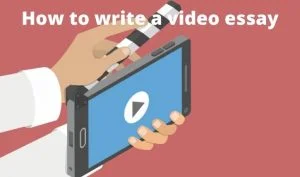
The video essay has become an increasingly popular way of presenting ideas and concepts in the age of the internet and YouTube. In this guide, we present a step-by-step guide on how to write a video essay and tips on how to make it.
While it is easy to write a normal essay, the structure of the video essay is a bit of a mystery, owing to the newness of the term.
However, in this article, we are going to define what is a video essay, how to write a video essay, and also How to present a video essay well in class.
What is a Video Essay?
A video essay is a video that delves into a certain subject, concept, person, or thesis. Video essays are difficult to characterize because they are a relatively new form, yet they are recognized regardless. Simply, video essays are visual compilations that try to persuade, educate, or criticize.

These days, there are many creatives making video essays on topics like politics, music, movies, and pop culture.
With these, essays have become increasingly popular in the era of video media such as Youtube, Vimeo, and others.
Video essays, like photo and traditional essays, tell a story or make a point.
The distinction is that video essays provide information through visuals.
When creating a video essay, you can incorporate video, images, text, music, and/or narration to make it dynamic and successful.
When you consider it, many music videos are actually video essays.
Since making videos for YouTube and other video sites has grown so popular, many professors are now assigning video essays instead of regular essays to their students. So the question is, how do you write a video essay script?
Steps on How to Write a Video Essay Script
Unscripted videos cost time, effort, and are unpleasant to watch. The first thing you should do before making a video writes a script, even if it’s only a few lines long. Don’t be intimidated by the prospect of writing a script. All you need is a starting point.
A video script is important for anyone who wants to film a video with more confidence and clarity. They all contain comparable forms of information, such as who is speaking, what is said, where, and other important details.
While there are no precise criteria that a video essay must follow, it appears that most renowned video essayists are adhering to some steps as the form gets more popular and acknowledged online.
1. Write a Thesis
Because a video essayist can handle a wide range of themes, video analysis essays lack defined bounds. The majority of essays, on the other hand, begin with a thesis.
A thesis is a statement, claim, theme, or concept that the rest of the essay is built around. A thesis might be broad, including a variety of art forms. Other theses can be quite detailed.
A good essay will almost always have a point to express. Every video analysis essay should have a central idea, or thesis, that ties the film together.
2. Write a Summary
Starting with a brief allows you and your team to document the answers to the most pressing project concerns. It ensures that everyone participating in the video production is on the same page.
This will avoid problems of mixing ideas or getting stuck when you are almost completing the project.
3. Choose a Proper Environment and Appropriate Tools
When it comes to writing your script, use any tool you’re familiar with, such as pen and paper. Also, find a writing atmosphere that is relaxing for you, where you can concentrate and be creative.
Consider what you don’t have to express out loud when you’re writing. Visual elements will be used to communicate a large portion of your content.
4. Use a Template
When you don’t have to reinvent the process every time you sit down, you get speed and consistency.
It’s using your cumulative knowledge of what works and doing it over and over again. Don’t start with a blank page when I sit down to create a script- try to use an already made template.
5. Be Conversational
You want scripts that use language that is specific and targeted. Always avoid buzzwords, cliches, and generalizations. You want your audience to comprehend you clearly without rolling their eyes.
6. Be Narrative
Make careful to use a strong story structure when you’re trying to explain anything clearly. Ensure your script has a beginning, middle, and end, no matter how short it is. This will provide a familiar path for the viewers of your video script.
7. Edit Your Script
Make each word work for a certain position on the page when you choose your words.

They must serve a purpose.
After you’ve completed your first draft, go over your script and review it.
Then begin editing, reordering, and trimming. Remove as much as possible.
Consider cutting it if it isn’t helping you achieve your goal.
8. Read Your Script Loudly
Before recording or going on in your process, it’s recommended to read your script aloud at least once. Even if you won’t be the one reading it, this is a good method to ensure that your message is clear. It’s a good idea to be away from people so you may practice in peace.
Words that flow well on paper don’t always flow well when spoken aloud. You might need to make some adjustments based on how tough certain phrases are to pronounce- it’s a lot easier to change it now than when recording.
9. Get Feedback
Sometimes it is very difficult to point out your mistakes in any piece of writing. Therefore, if you want a perfect video essay script, it is advisable to seek feedback from people who are not involved in the project.
Keep in mind that many will try to tear your work apart and make you feel incompetent. However, it can also be an opportunity to make your video better.
The best way to gather feedback is to assemble a group of people and read your script to them. Watch their facial reaction and jot own comments as you read. Make sure not to defend your decisions. Only listen to comments and ask questions to clarify.
After gathering feedback, decide on what points to include in your video essay. Also, you can ask someone else to read it to you so that you can listen to its follow.
A video essay can be a good mode to present all types of essays, especially compare and contrast essays as you can visually contrast the two subjects of your content.
How to make a Good Video from your Essay Script
You can make a good video from your script if you ask yourself the following questions;
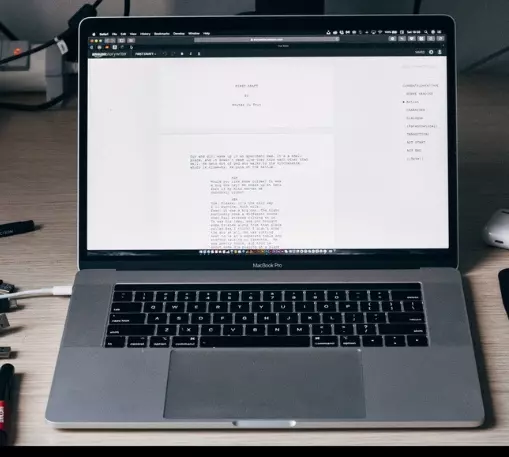
- What is the video’s purpose? What is the purpose of the video in the first place?
- Who is this video’s intended audience?
- What is the subject of our video? (The more precise you can be, the better.)
- What are the most important points to remember from the video?- What should viewers take away from it?
If the context had multiple characters, present their dialogues well in the essay to bring originality. If there is a need to involve another person, feel free to incorporate them.
How to Present a Video Essay Well in Class
- Write down keywords or main ideas in a notecard; do not write details- writing main ideas will help you remember your points when presenting. This helps you scan through your notecard for information.
- Practice- in presentations it is easy to tell who has practiced and who hasn’t. For your video essay to grab your class and professor’s attention, practice is the key. Practice in front of your friends and family asking for feedback and try to improve.
- Smile at your audience- this is one of the most important points when presenting anything in front of an audience. A smiley face draws the attention of the audience making them smile in return thus giving you confidence.
- Walk to your seat with a smile- try not to be disappointed even if you are not applauded. Be confident that you have aced your video presentation.
Other video presentations tips include;
- Making eye contact
- Have a good posture
- Do not argue with the audience
- Look at everyone around the room, not just one audience or one spot
- Rember to use your hand and facial expressions to make a point.

Joseph is a freelance journalist and a part-time writer with a particular interest in the gig economy. He writes about schooling, college life, and changing trends in education. When not writing, Joseph is hiking or playing chess.
The Video Essay As Art: 11 Ways to Make a Video Essay
Part one in a series of commissioned pieces on video essay form, originally published at Fandor Keyframe.
This feature piece, the first in an ongoing series, was originally published by Fandor Keyframe in May 2016. You can read the other pieces in this series here .
When you think of the video essay, you might imagine someone expressing their love of a movie over a selection of clips, a compilation of a famous director’s signature shots, or a voice that says: “Hi, my name is Tony.” But these are just a few of a remarkable variety of approaches to making videos exploring film and media, a diversity of forms that is continually evolving and expanding. Here’s an attempt to account for some of the more recognizable modes of video essay, with key examples for each.
Supercut . A collection of images or sounds arranged under a category (i.e. Jacob T. Swinney’s wonderful The Dutch Angle ) or used to break down a film to a set of elements (i.e. Zackery Ramos-Taylor’s recent Hearing Star Wars: The Force Awakens and Joel Bocko’s The Colors of Daisies ). The supercut is usually very short and lacks text so as to maximize its impact on a visual level. This brevity of form emphasizes a central concept more than a narrative argument. If a supercut has an argument to make, it is typically in the order in which items are sequenced.
Personal Review . This broad category of video essay hinges on a strongly personalized account of a film. Scout Tafoya’s recurring series The Unloved is a prominent example of this, wherein he makes the claim that each film he focuses on is underappreciated and then asserts their qualities through visual analysis. The best of these, in my opinion, is his video on Michael Mann’s Public Enemies :
Vlog . While similar to the personal review, the vlog differs strongly in mode of presentation. There is a greater focus on direct address of the viewers, and on delivering opinion rather than analysis. They’re often played up for comedic entertainment value and feature a lot of voiceover or footage of the editor themselves. Chez Lindsay’s video on Joel Schumacher’s The Phantom of the Opera is a sprawling, informative, funny journey through theater and cinema history that in many respects encompasses elements of the video essay but first and foremost is grounded in a personal perspective. Outside of film, the work Jon Bois does at SB Nation in his series Pretty Good would also fall under this category (his latest, on character types in 24 , is very much worth the watch). The popular YouTube series CinemaSins would also fall under this category, which relies moreso on personal nit-picking than film analysis.
Scene Breakdown . A visually-driven close reading of a scene (or many scenes in one film) that leans heavily on explaining film form and technique. Tony Zhou is especially skilled at this, and his scene breakdowns often come nestled in a video about many scenes, like his look at ensemble staging in Bong Joon-ho’s Memories of Murder or the approach to staging a fight scene in his video Jackie Chan—How to Do Action Comedy :
Shot Analysis . A cousin of the supercut and scene breakdown, though more analytical in nature than the former, the shot analysis dissects a shot or a repeated type of shot. Josh Forrest’s engaging video on the insert shot in David Fincher’s Zodiac is not shot analysis in and of itself; it’s more of a supercut. David Chen’s Edgar Wright and the Art of Close-Ups , on the other hand, is definitely a shot analysis, turning its compilation structure into a video essay by virtue of its director’s commentary track (which we might call the DVD-era ancestor of the video essay):
Structural Analysis . To paraphrase Kurt Vonnegut, these videos look at a film’s story shape, seeking to uncover hidden meaning or a subtextual emphasis by viewing the film as a collection of scenes rather than necessarily a plot or narrative. Kevin B. Lee’s Between the Lines: THE DAY HE ARRIVES is one of the best videos in this field, comparing repeated scenes in Hong Sang-soo’s film to reveal the film’s playful interpretation of time passing. One of my video essays for Fandor last year, Containing the Madness: George A. Romero’s THE CRAZIES , was an attempt to engage with this mode of video essay:
Side-by-side Analysis . Not a supercut, not yet a shot analysis. The side-by-side is a fascinating form of the video essay pushed by essayists like Cristina Álvarez Lopez, Catherine Grant ( All That Pastiche Allows ) and, in recent months, Davide Rapp, which finds meaning through visual comparison of two or more film clips in real-time. In What is Neorealism? , kogonada brilliantly employs the side-by-side comparison to reflect on the ideological and creative differences between Vittorio de Sica and David O. Selznick in the cutting of the same picture.
Side-by-sides with voiceover narration are relatively rare. Álvarez, Grant and Rapp tend to let viewers interpret the footage on their own. Rapp’s series of videos under the Seeing Double and Seeing Triple moniker place sequences from films and their various remakes side-by-side and implicitly address not only specific but generational aesthetic and narrative priorities. A particularly illuminating video in this collection is his look at Michael Haneke’s two versions of Funny Games :
Recut . The line between video essay and video art is blurred when we look at the imaginative re-purposing of texts. Filmscalpel’s 12 Silent Men is a good example of this, which was shared as a video essay despite being very similar in form to Vicki Bennett’s work of video art, 4:33: The Movie . Davide Rapp’s enchanting SECRET GATEWAYS (below), where he maps the space of a house in a Buster Keaton short and then moves his virtual camera between each of these rooms, is a more visually-focused re-purposing. I’d count my video essay, The Secret Video Essays of Jenni Olson , as also being a part of this form. It’s worth noting that an imaginative recut does not need to be visual, it can also be conceptual, as in Jeremy Ratzlaff’s Paul Thomas Anderson: A Chronological Timeline . This recut concept also extends to re-purposed marketing materials or film trailers, as seen in The Maze of Susan Lowell by Cristina Álvarez López and Adrian Martin, which suggests an alternate cut of The Big Combo with Susan as the protagonist. The very popular YouTube series Honest Trailers would also fall into the category of the recut, as they mimic and parody film trailer form, though their comedic narration-as-criticism does blur the line even more.
Subject Essay . These videos typically tell a story to explore a filmmaker’s (or actor’s, cinematographer’s, etc.) body of work, an era of filmmaking or a recurring motif in a lot of films, incorporating elements of scene, shot and thematic analysis. For the most part, the better videos in this field seek to educate or inform the viewer about a relatively unknown body of work or period of time. In this vein they teeter on the edge of conventional documentary cinema, like Kevin B. Lee’s Bruce Lee, Before and After the Dragon , and are reminiscent of some of the essay films of Mark Rappaport (whose body of work in and of itself defies easy genre labels). An unconventional example of this, and one of the best video essays of 2015, is Tony Zhou’s Vancouver Never Plays Itself . Another unconventional example, and one which straddles the modes of supercut and shot analysis, is Rishi Kaneria’s brilliant Why Props Matter .
Academic Supplement . When Kevin B. Lee made his refractive video essay What Makes a Video Essay Great? back in 2014, he used an excerpt from Thomas van den Berg’s Reliable Unreliability vs Unreliable Reliability or, Perceptual Subversions of the Continuity Editing System , a chiefly academic piece of video criticism that runs for over half an hour, features lecture-like narration and is grounded in academic and theoretical concepts of cinema. While this video does stand on its own as analysis, when I say supplement I mean that it is supplemental to the academic form. Some of the video works from David Bordwell, which he has termed video lectures, are examples of this form, in spite of what they have in common with shot analysis and filmic survey (in particular, his Constructive Editing in Robert Bresson’s Pickpocket ). Catherine Grant, another academic working in the realm of video essays, has managed to often subvert this expectation that academics making video essays will make supplementary works, turning in some wonderfully imaginative and non-academic videos like her brilliant UN/CONTAINED .
Desktop Video . A recent mode of video arguably born from the metatextual work of Harun Farocki ( Interface in particular), this seeks to present an argument about film within the confines of a computer screen. It’s worth noting that while the visual experience is tethered to a screen, like the recent horror flick Unfriended, it’s often not actually a real-time one-take desktop journey. The defining film in this field (arguably moving beyond the video essay label to become an experimental documentary in its own right) is Kevin B. Lee’s Transformers: The Premake :
As you can see from the various definitions above, the problem with all of these videos standing under the umbrella category of the video essay is that they’re all trying to do different things and aiming for different audiences. Because of this, when any two practitioners talk about what they like in video essays, they may be talking about very different things, not just in terms of content but in what they think the purposes of these videos are. Earlier this month Filmmaker Magazine posted a series of responses to the question What is a Video Essay? and answers ranged from a tool to stimulate better film viewing to a new form of essay filmmaking; and from a means of expressing cinephile obsession to a means of critiquing that same obsession.
On the other hand, what’s certain is that these videos, in their multitude of forms, have become very popular online over the last few years. There are many communities forming in the world of video essays, not just within publishing sites like the one you’re visiting now, but also in the “schools” of approaches taken by like-minded video makers. The mostly straightforward film-analysis approach is a favorite among very popular YouTubers. The academic-minded teaching aide is championed by the online journal [in]Transition. The personal love letter to cinema arises in supercuts and most single-film videos. The miniature essay film floats in and out of categorization, making it one of the most interesting forms of video essay.
Here at Keyframe I’ll be writing about various approaches to the video essay, looking at a wide variety of videos and video essayists and speaking to curators and editors to try to understand just how we got to where we are now. I’ll explore questions such as: why do some supercuts work better than others; when and when not to use voiceover and much more. Join us, won’t you?
How to make a video essay: A guide for beginners

What type of content do you primarily create?

Video essays are an incredibly popular genre on YouTube, and many new creators are eager to have their views heard on topics in culture and politics. But making a video essay involves a lot more than just sitting in front of a camera and pressing record. This guide is intended for beginners who don’t quite know where to start.
What is a video essay?
A video essay’s primary defining feature is that it sets out to make an argument. It is, to put it simply, like an essay you wrote in school. Video essays often cover politics, popular media, or science.
But unlike the essays you wrote in school, video essays need extensive visual accompaniment, whether that’s footage (or B-roll ), still images, or animation.
Here’s how you can get started:
Step 1: Craft a thesis
Good video essays will have a central thesis explored throughout the piece. If you can’t summarize your thesis in a sentence (sometimes two), you’ve still got work to do. The best theses immediately leave the viewer wanting to know more. Test it on friends: If you state your thesis to friends and get reactions of curiosity or excitement you’re on to something.
Consider one of my favorite video essays, whose thesis is right in the title: "Why Snowpiercer is a sequel to Willy Wonka and the Chocolate Factory."
Sometimes, a thesis is a little more subtle, but nonetheless important. In Yhara Zayd’s video on horror movies, she argues that horror has always been a genre for social criticism.
The rest of your video isn’t just proving that thesis, though that’s important. You'll want to explore the twists and turns of the idea. What questions does your thesis raise? What are the big doubts about your thesis, and how do you address them? How can we zoom out from your thesis and ask even bigger questions?
Step 2: Determine your audience
Your audience will dictate what level of complexity and detail you should cover in your video. If you’re an engineering channel, maybe you want to appeal to working engineers who understand the jargon of the profession. But if you’d like a broader audience, you’ll need to take the time to define terms and give background information. The best video essays usually appeal to both—their topics are unique enough to be interesting to people with prior knowledge of the topic, while accessible enough to be understood to a casual viewer.
Step 3: Organize your research early
Your video essay should have lots of supporting evidence. Aside from the usual list of articles and books, video essays can also use visual evidence.
If you’re commenting on media, that means hyper-specific shots and lines of dialogue. If you’re commenting on history, that means old news clips. Filmed interviews are a great resource regardless of the topic.
Whenever I'm trying to cover a show, I’ll watch the show (sometimes twice), take extensive notes, pause to write out lines of dialogue, and mark where specific moments supported various themes, motifs, or ideas.
I've always regretted telling myself I’d remember a specific line or shot because I'd find myself spending an hour to hunt it down later in the process.
Whether you’re commenting on news footage, video games, or film and TV, I cannot stress enough how much extensive notetaking will improve your video essay later in the process.
The same advice goes for any books or news articles you might cite: annotate extensively and cite them in your piece.
Step 4: Familiarize yourself with "fair use"
Many video essays source footage from the news, TV, and film without licensing them. I'm not here to give advice on the legality of that, but I do think any video essayist should familiarize themselves with fair use .
Fair use is a set of criteria that a creator can use to defend their use of copyrighted work. It's not a license to freely use copyrighted work if you think you fit those standards; it’s a series of tests a judge should weigh in court.
Usually, it doesn’t come to that. Most copyright issues go through YouTube’s copyright claim system , which you should also read up on. A film studio may claim your content, or block it altogether, for using their copyrighted material. YouTube allows you to appeal these claims , but if both parties won’t give up, the question can only be settled by a judge (in the US, at least).
Step 5: Start your script
Be sure to use a two-column script, rather than just writing out everything as if it were a traditional essay.
In one column, you’re writing what you’re saying, or what the footage is saying. In the other, write what you plan to show. Your notes here should be specific enough to help you later in the editing process. You may want to add a third column for notes, or sources to cite later.
Writing a video essay follows some different rules than what your English teacher might have expected. Most video essays use a conversational style, and include words, phrases, and grammar that would never fly with the written word. Sometimes that includes filler words, like starting a sentence with “so” or putting an “um” for effect. Just don’t overdo it.
Other writing rules still apply. Be concise, use active verbs, and otherwise just make sure you sound like a human.
Step 6: Film (or record)
You don’t need a $10,000 filming setup to make good video essays. Plenty of people start with just a microphone, completely avoiding the camera altogether in what's known as a faceless YouTube video .
The two most important things to recommend: get good sound, and be natural. People can tolerate a lot of visual sins, but usually won’t put up with bad audio quality. Similarly, you don’t need to have the charisma of a talk show host, but people have no tolerance for on-screen performances that seem forced or fake.
That is all to say, get a decent microphone and be yourself. If you’re on-screen, buy a cheap teleprompter setup for your phone or camera.
Step 7: Start editing
There are many options for video editing software out there (and Descript is a great one), even for people with limited video editing experience. This article isn’t long enough to be an editing guide , but a few quick tips for a true novice:
- Don’t linger on any one visual for too long. Instead, mix up the visual interest of your video.
- Emphasize important concepts with text on screen.
- Take the time to learn a little about color grading .
- Clean up any noticeable background noise .
Step 8: Figure out your title and thumbnail
This may be the last step of this article, but it should often begin while you’re brainstorming. Your title and thumbnail should generate intrigue without giving it all away. Video essays often lean on titles with “How” and “Why.” Lessons from the Screenplay is a good example:
But video essays can also make provocative statements that make the viewer curious about how you’ll back it up. Consider Kurzgesagt – In a Nutshell’s “ Smoking is Awesome ,” which I promise is not pro-tobacco.
Step 9: Publish
Finally, it's time to put your video out into the world and see how it fares. Your first video essay won't be perfect. It's important to put your work in public, take in feedback, and move on to your next project. Like all things, skill comes with time.
Related articles

Featured articles:

Podcast grants 101: How to get funding for your show
Podcasts cost money, and podcast grants can help. Discover the various grants available and essential tips for a successful application.

Descript tutorial for beginners: 6 steps to get started
Hit the ground running with this Descript tutorial. Import, edit, and publish your audio or video project with the intuitive text-based editor.

30 faceless YouTube channel ideas for anonymous engagement
Discover 30 faceless YouTube channel ideas to drive engagement and make money without showing your face.

How much do YouTubers make? See real-world examples
There's no single answer to how much YouTubers make. But whatever your channel size, this article will give you a good idea of what to expect.

How to start a podcast on Spotify: 7 easy steps
Find everything you need to launch a successful podcast on Spotify, from setup to publishing.

For Business
How to create an internal company podcast to keep employees connected
Learn how to boost company culture and improve communication with an internal podcast in this step-by-step guide.
Articles you might find interesting

AI for Creators
Why ChatGPT struggles with math—and why that matters
We expect computers to excel at math, so why is ChatGPT so bad at it? The answer sheds light on a lot we need to keep in mind about AI tools.

Game Streaming Setup: 9 Gaming VOD Must-Haves
If you want to build an audience, achieve stardom, and land those endorsement deals, you’ll want a way to record your game stream so people can watch asynchronously.

15 brilliant podcast segment ideas, with examples from actual shows
An engaging, repeatable segment or two in your podcast can keep listeners coming back for more.

How They Made It
How They Made It: The Overlook's Matt Peiken on the value of a local podcast
Matt Peiken is using podcasting to create the kind of local news coverage that’s fast disappearing all over the country. We asked him how he does it.
%20(1).JPG)
What You Need to Know to Make Animated Videos
If you’re sick of slideshow presentations, it might be time to try animation videos. It’s easier than you might think, here are some solid options to step up and try.

How to edit videos: A beginner’s tutorial (2024)
There’s no one right or wrong way to edit a video, but there are some essential tips you should know to make things go more smoothly.
Join millions of creators who already have a head start.
Get free recording and editing tips, and resources delivered to your inbox.
Related articles:
Share this article
- Login / Sign Up
- Entertainment
What it takes for video essayists to breakthrough on YouTube
Lindsay Ellis, Michael Tucker, T1J, Maggie Mae Fish, and Patrick Willems discuss the art of dissecting art
by Polygon Staff
If you buy something from a Polygon link, Vox Media may earn a commission. See our ethics statement.
In the last 10 years, YouTube video essays — on movies, on TV shows, on games, on pop culture, on everyday life — have entered a renaissance. But how do you make a video essay? What does it take to run a YouTube channel that can let a creator’s creativity thrive and serve a demanding audience? How much do algorithms control the pop conversation, and how is someone supposed to break through?
Knowing that dissecting art is an art in itself, Polygon asked some of the top video essayists working on YouTube today to come together in conversation at the 2020 New York Comic Con Metaverse. On Saturday at 9 p.m. EDT/ 6 p.m. PDT, Lindsay Ellis , Michael Tucker ( Lessons from the Screenplay ), Kevin Peterson ( T1J ), and Maggie Mae Fish join moderator, fellow creator, and occasional Polygon contributor Patrick Willems to talk through their career arcs and reflect on what it takes to make a career out of video essays.
Want a taste?
“YouTube really encourages you to fixate on numbers and the algorithm,” Ellis says during the roundtable. “And the way the backend is set up [...] it’s designed to play to your anxiety and it’s designed to, like, make you freak out if your video isn’t doing as well as the last 10. I would like to be emotionally liberated from that because I do think it creatively stifles you. You’re making content based not on what you’re interested in, but what you think will get clicks. I wish I could just be OK with the fact that I’m not going to get a million views a video anymore. That should be OK. I should be allowed to do that.”
Watch the full, 45-minute panel above for even more insight and anecdotes.
- New York Comic Con
More in Polygon at NYCC 2020

Most Popular
- Anker's two-headed USB-C cable is a $22 blessing
- The Baldur's Gate 3 team isn't finished with the game yet
- A good game like Concord just isn’t good enough anymore
- The Boy and the Heron, Twilight of the Warriors, Netflix’s Rebel Ridge, and every movie new to streaming this week
- Grid's tastefully destroyed Game Boys make for great art, and they're 40% off now
Patch Notes
The best of Polygon in your inbox, every Friday.
This is the title for the native ad
More in Entertainment

The Latest ⚡️
Visual Rhetoric
Video essay resource guide.
PAR 102 (M-Th, 9 AM- 5 PM) Fine Arts Library Media Lab (same hours as FAL) PCL Media Lab (same hours as PCL)
About video essays
What are they.
“The video essay is often described as a form of new media, but the basic principles are as old as rhetoric: the author makes an assertion, then presents evidence to back up his claim. Of course it was always possible for film critics to do this in print, and they’ve been doing it for over 100 years, following more or less the same template that one would use while writing about any art form: state your thesis or opinion, then back it with examples. In college, I was assured that in its heart, all written criticism was essentially the same – that in terms of rhetorical construction, book reviews, music reviews, dance reviews and film reviews were cut from the same cloth, but tailored to suit the specific properties of the medium being described, with greater emphasis given to form or content depending on the author’s goals and the reader’s presumed interest.”
Matt Zoller Seitz on the video essay .
what makes a good video essay?
Tony Zhou on how to structure a video essay
Kevin B. Lee on what makes a video essay “ great “
why should we use them? what are their limits?
Kevin B. Lee’s experimental/artistic pitch for video essays
Kevin B. Lee’s mainstream pitch for video essay
“Of all the many developments in the short history of film criticism and scholarship, the video essay has the greatest potential to challenge the now historically located text-based dominance of the appraisal and interpretation of film and its contextual cultures…”
Andrew McWhirter argues that t he video essay has significant academic potential in the Fall 2015 issue of Screen
“Importantly, the [new] media stylo does not replace traditional scholarship. This is a new practice beyond traditional scholarship. So how does critical media differ from traditional scholarship and what advantages does it offer? First, as you will see with the works in this issue, critical media demonstrates a shift in rhetorical mode. The traditional essay is argumentative-thesis, evidence, conclusion. Traditional scholarship aspires to exhaustion, to be the definitive, end-all-be-all, last word on a particular subject. The media stylo, by contrast, suggests possibilities-it is not the end of scholarly inquiry; it is the beginning. It explores and experiments and is designed just as much to inspire as to convince…”
Eric Fadden’s “ A Manifesto for Critical Media “
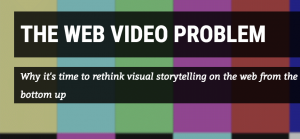
Adam Westbrook’s “ The Web-Video Problem: Why It’s Time to Rethinking Visual Storytelling from the Bottom Up “
Video essayists and venues
Matt Zoller Seitz (various venues) A writer and director by trade, Zoller Seitz is nonetheless probably best known as a prominent American cultural critic. He’s made over 1000 hours of video essays and is generally recognized as a founder of the video essay movement in high-brow periodicals. A recognized expert on Wes Anderson, Zoller Seitz is also notable because he often mixes other cinematic media (especially television) into his analysis, as in the above example, which doubles as an experiment in the absence of voiceover.
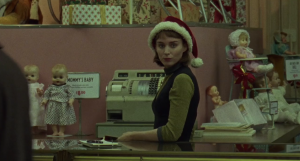
Various contributors, Press Play Co-founded by Matt Zoller Seitz and Ken Cancelosi, Press Play (published by Indiewire) is one of the oldest high-brow venues for video essays about television, cinema, and other aspects of popular culture.
Various contributors, Keyframe (A Fandor online publication) Fandor’s video essay department publishes work from many editors (what many video essayists call themselves) on and in a range of topics and styles. Check it out to get an idea of all that things a video essay can do!

Various contributors, Moving Image Source A high-brow publication for video essays.
Tony Zhou, Every Frame a Painting The master of video essays on filmic form, Tony’s arguments are clean, simple, and well-evidenced. Look to Tony as an example of aggressive and precise editing and arrangement. He’s also an excellent sound editor–pay attention to his choices and try out some of his sound-mixing techniques in your essay.
Adam Johnston, Your Movie Sucks (YMS) Although an excellent example of epideictic film rhetoric, this channel is a great example of what not to do in this assignment (write a movie review, gush about how good/bad you think a movie is, focus on motifs or narrative content instead of film form as the center of your argument). What you can learn from Adam is a lot about style. Adam’s delivery, pacing, and editing all work together to promote a mildly-disinterested-and-therefore-credible ethos through a near-monotone, which I’ll affectionately dub the “Daria” narratorial ethos.
Adam Westbrook, delve.tv Adam Westbrook is part of an emerging group of professional video essayists and delve.tv is his version of a visual podcast. Using the video essay form, Adam has developed a professional public intellectual ethos for himself through skillful overlay of explanation/interpretation and concept. Check out Westbrook’s work as a really good example of presenting and representing visual concepts crucial to an argument. He’s a master at making an argument in the form of storytelling, and he uses the video essay as a vehicle for that enterprise.
:: kogonada (various venues) If you found yourself wondering what the auteur video essay might look like, :: kogonada is it. I like to call this “expressionist” video essay style. Kogonada is the ultimate minimalist when it comes to voiceover/text over–its message impossibly and almost excessively efficient. Half of the videos in his library are simple, expertly-executed supercuts , highlighting how heavily video essays rely on the “supercut” technique to make an argument. Crafting an essay in this style really limits your audience and may not be a very good fit for the constraints of assignment (very “cutting edge,” as we talked about it in class), but you will probably draw inspiration from ::kogonada’s distinct, recognizable style, as well as an idea of what a video essay can do at the outer limits of its form.
Lewis Bond, Channel Criswell Narrating in brogue-y Northern English, Bond takes his time, releasing a very carefully-edited, high-production video essay once every couple of months. He’s a decent editor, but I feel his essays tend to run long, and I feel rushed by his narration at times. Bond also makes a useful distinction between video essays and analysis/reviews on his channel–and while most of his analysis/reviews focus on film content (what you don’t want to imitate), his video essays stay pretty focused on film technique (what you do). Hearing the same author consciously engage in two different modes of analysis might help you better understand the distinction between the two, as well.
Jack Nugent, Now You See It Nugent’s brisk, formal analysis is both insightful and accessible–a good example of what it takes to secure a significant following in the highly-competitive Youtube marketplace. [That’s my way of slyly calling him commercial.] Nugent is especially good at pairing his narration with his images. Concentrate and reflect upon his simple pairings as you watch–how does Nugent help you process both sets of information at the pacing he sets?
Evan Puschak, The Nerdwriter Nerdwriter is a great example the diversity of topics a video essay can be used to craft an argument about. Every week, Puschak publishes an episode on science, art, and culture. Look at all the different things Puschak considers visual rhetoric and think about how he’s using the video essay form to make honed, precisely-executed arguments about popular culture.
Dennis Hartwig and John P. Hess, FilmmakerIQ Hartwig and Hess use video essays to explain filmmaking technique to aspiring filmmakers. I’ve included the channel here as another example of what not to do in your argument, although perhaps some of the technical explanations that Hartwig and Hess have produced might help you as secondary sources. Your target audience (someone familiar on basic film theory trying to better understand film form) is likely to find the highly technical, prescriptive arguments on FilmIQ boring or alienating. Don’t focus on technical production in your essay (how the film accomplishes a particular visual technique using a camera); rather, focus on how the audience interprets the end result in the film itself; in other words, focus on choices the audience can notice and interpret–how is the audience interpreting the product of production? How often is the audience thinking about/noticing production in that process?
Kevin B. Lee (various venues) A good example of the older, high-brow generation of video essayists, Kevin’s collection of work hosted on his Vimeo channel offers slow, deliberate, lecture-inspired readings of film techniques and form. Note the distinct stylistic difference between Kevin’s pacing and someone like Zhou or Lewis. How does delivery affect reception?
Software Guides
How to access Lynda tutorials (these will change your life)
Handbrake and MakeMKV (file converters)
Adobe Premiere (video editing)
Camtasia (screen capture)
File management
Use your free UTBox account to upload and manage your files. Make sure you’ve got some sort of system for tracking and assembling everything into your video editing software. UTBox has a 2 terabyte limit (much higher than Google Drive) and is an excellent file management resource for all sorts of academic work.
Adobe Premiere saves versions with links to your video files, so it’s imperative that you keep your video files folder in the same place on every machine you open it up on. That’s why I keep all my video files in a big folder on box that I drop on the desktop of any machine I’m working on before I open my premiere files. The Adobe Premiere project walkthrough has more details on this.
Where to find video and how to capture it
About fair use . Make sure your composition complies with the Fair Use doctrine and familiarize yourself with the four criteria.
The best place to capture images is always from a high-resolution DVD or video file . The first place you should go to get the film is the library– see instructions for searching here .
To import the video and audio from your DVD or video file into your video editing software (like Premiere), you will first need to use a software to convert it to an .mkv. See instructions on how to do that here .
Camtasia tutorials . Camtasia is a program that allows you to capture anything that’s going on on your screen . This is a critical tool for this assignment as you decide what kind of interface you want to present to your reader in your video essay. Camtasia also allows you to capture any high-quality video playing on your desktop without licensing restrictions.
You can also use Clip Converter to capture images and sound from pre-existing YouTube videos , and it may be a little faster and easier than Camtasia. I suggest converting things into .mkv before putting them into your video editor, regardless of where you get the material from.
Film theory and criticism
- /r/truefilm’s reading and viewing guide
Leave a Reply Cancel reply
You must be logged in to post a comment.
How to do a Video Essay: The Video Essay Process
- Plan, Prepare & Create
Storyboarding
- Finding, Filming & Editing
- References & Credits
- The Video Essay Process
This section will give an introductory overview of the stages required to create a video essay. Video essayers advice is to start simple and work through each stage of the video production process. Visit the Resources page of this guide for more.
Identify what is your argument? What is it that you want to communicate to the viewer? Write this down in a few sentences, refer and modify it as required.
Watch Video Essays
Watch a selection of video essays, read blogs and web pages from video essayers and decide what type of video essay you would like to create. Start simple.
A storyboard is a detailed outline (similar to an outline in a written essay) that helps you to organise and visualise the video essay as to what is on the screen, text, media, message and transitions between shots.
Storyboards assist in determining the length, message and meaning of the video essay and help save time with editing and post production processes.
- Free Storyboard Templates
Collect & Edit
Collect video material as downloads, ripping DVDs, screen grabs, mobile phone footage and create voice-overs. Use research skills to find information and statements to support your argument. Maintain a standard of quality and manage your videos by naming conventions and storage.
Use editing software and experiment with available functionality to enhance and support your argument. Add a voice-over, sound effects, music and other aspects of multimodality. Be sure to include references and credits to all sources used in creating the video essay.
Revisit elements of your video essay and modify as required.
Visit the Resources page of this guide for more.
- Where to find video and how to capture it
- Video Editing Basics - iMovie
- Software Guides
References & Credits
References to cite sources used in the Video Essay. Referencing is a formal, systematic way of acknowledging sources that you have used in your video essay. It is imperative that you reference all sources used (including videos, stills, music, sfx) and apply the correct formatting so that references cited can be easily traced. The referencing style used at ECU is the APA style, 6th ed. 2010. Refer to the ECU Referencing Library Guide for accurate citation in APA style.
Production credits Individuals: acknowledgement of individuals and their role in the production. Purpose: A statement for internal use, e.g. “This video was produced for [course name] at [institution’s name] in [semester, year]”
- Referencing Library Guide
- << Previous: What is a Video Essay?
- Next: Modes, MultiModality & Multiliteracies >>
- What is a Video Essay?
- Modes, MultiModality & Multiliteracies
- A Pedagogy of Multiliteracies
- Modes Of Multimodality
- Video Essay Journals
- Video Essay Channels
- Weblinks to Video Essay Resources
- Weblinks to Creative Commons Resources
- Titles in the Library
- Referencing & Copyright
- Marking Rubric
- Last Updated: Aug 28, 2023 2:57 PM
- URL: https://ecu.au.libguides.com/video-essay
Edith Cowan University acknowledges and respects the Noongar people, who are the traditional custodians of the land upon which its campuses stand and its programs operate. In particular ECU pays its respects to the Elders, past and present, of the Noongar people, and embrace their culture, wisdom and knowledge.
We use cookies to improve your browsing experience and to personalise content for you. See our privacy and cookie policy .
Home Resources Free Guides Video Essays Guide
Video Essays Guide
Introductory guide to video essays., drawing on the inspiring work of pioneering educators and researchers engaging with this creative method, this guide aims to offer a research-led introduction for students, teachers and researchers approaching the video essay for the first time..
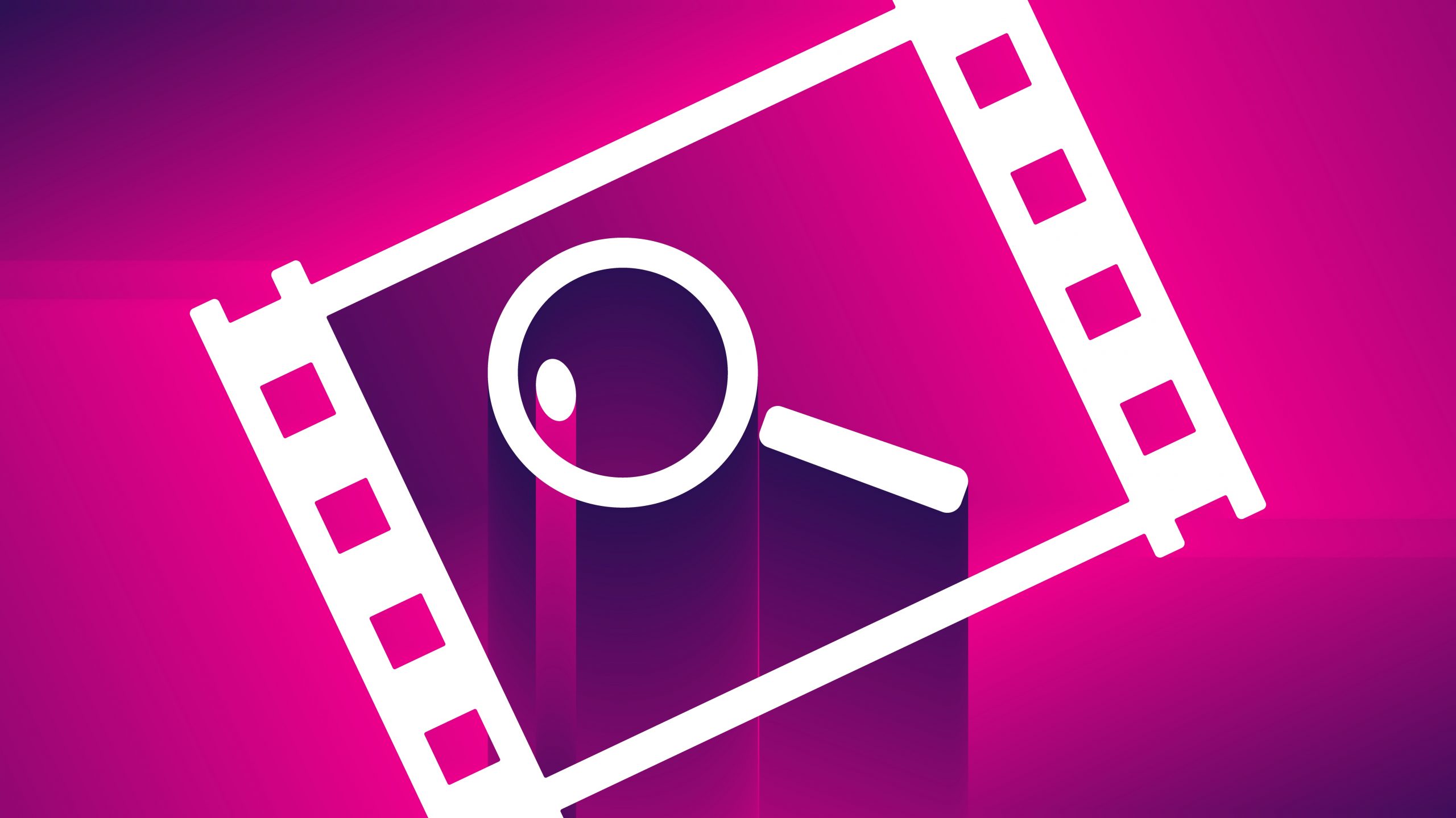
Introduction to Video Essays
Studying and researching film through film
A research-led introduction for students, teachers and researchers approaching the video essay for the first time.

Finding Coherence Across Journals
Guidelines and criteria for making, curating and publishing video essays
A look at the existing guidelines for the production and evaluation of video essays.

How To Make Video Essay Guides
Preproduction, Production, Postproduction
Considerations for planning, making and editing a video essay.

Copyright Considerations
How copyright law regulates the creative reuse of existing materials
Understanding the basic principles of copyright law when producing or using creative works.

Dissemination
A selected list of journals and websites where you can publish video essays.

Video essays as creative assessment method at SOAS, University of London
Reducing the uncertainty around creative assessment methods.
About this guide
Authors's biographies, list of references and contact details
Launch Event
An online event organised by Learning on Screen in collaboration with SOAS, University of London.
Media Production and Film Studies
- Library Resources
- Finding Books
- Professional Organizations
- Careers in Media
- The Video Essay
So you want to make a video essay...
The video essay: how-to, featured video essays.
- Copyright & Fair Use
- Getting Help
Additional Resources
Academic Journals
- in[Transition] : The first open access, peer-reviewed journal on videographic criticism
- AUDIOVISUALCY: Videographic Film and Moving Image Studies : An online forum for video essays or works of audovisual screen studies that have an analytical, critical, reflexive or scholarly purpose; fully attribute all sources used; are made according to Fair Use principles; are non-commercial in nature.
Video Essay Channels
- Every Frame a Painting
- Indietrix Film Reviews
- 100 Years of Cinema
- Channel Criswell
- Lindsay Ellis
Library Guides
- Tufts University Library: Multimedia Production
- Edith Cowan University Library: The Video Essay
- Pace University Library: Film Criticism
What is a video essay ?
Christian Keathley, a Professor of Film & Media Culture at Middlebury College & co-founder of in[Transition], defines video essays as
“short critical essays on a given film or filmmaker, typically read in voice-over by the author and supplemented with carefully chosen and organized film clips”
Video essays have found incresased popularity in recent years on digital content sharing platforms like YouTube & Vimeo. Despite their scholarly-focused and argument-driven nature, video essays have since been associated with (and mistaken for) other popular forms of commentary (e.g. movie commentaries, reaction videos, online fan-edits, etc.) shared on the same platforms. The two do have similarities in their accessibility and utilize the same set of creative tools and texhniques. However, the video essay in its academic form does follow certain conventions (a written critical component from the author, scholarly research, and peer review), as opposed to popular commentaries.
Video essays as a medium are an important audivisual form of scholarship, particularly in terms of expression, creation, and accessibility. Traditional essays may not always lend themselves to the fullest expression of film and how we interpret/analyze visual images. As students of film and media studies, it is important to both understand the medium from a critical point of view, as well as from a creative point of view.
- Planning & Preparation
- Gathering Materials & Filming
- Editing & Sharing
- Understanding File Formats
So you've been assigned a video essay for class, or you want to make one on your own...
Where do you start? Like any other form of traditional essay, you will begin by Developing A Topic , whether it's a persuasive argument, a narrative story, or a research question. If you’re telling a story, think about good elements of narrative. If you’re making an argument in your video essay, think about the elements of making an effective argument. If you're drafting a research question, make sure to be specific and answer the following: who?, what?, where?, when?, why?, and how?
For more information about developing a topic or researcj question, please check out the following resources:
- Pace Library Guide: The Research Process, Step-By-Step
- Pace Library Guide: Getting Started with Research
Once you have a well-developed topic and/or research question, then you can Create an Outline and Write a Script for your video essay. Utilizing your background research, evidence from whichever piece(s) of media you are analyzing/discussing, and your own arguments/interpretations of that media, you can build an outline and write a basic script to refer to when filmming and/or recording your video essay. This script will especially be important if you plan to record a voiceover.
For more information about how to write a script/create an outline, please check out the following resources:
- Excelsior Online Writing Lab: Video Essays
- How To Make A Video Essay: Writing by Indietrix Film Reviews
Now, you've got your script and you're ready to start gathering materials (scenes, images, audio, etc.) to edit into your video essay. The best place to capture images is always from a high-resolution DVD, Blue-ray, or video file.
There are a couple of different places you can acquire these files. Of course, you can always invest in your own copies of the physical media. This is the best (and most ethical ) way to get high quality images, video, and footage.
Should you wish to do a screen capture, you can use platforms like Camtasia or Clip Converter to record images or footage directly from your screen. These aren't always the most ethical means to record footage, so if you choose to do so, be sure to consult Fair Use Guidelines before doing so. For this process, you will also likely need a DVD Drive, whether external or internal. Having one that can read DVDs and Blu-rays is a plus! Resoruces for how to do these technical processes are included below.
Before you actually aquire any footage or media for your video essay, it's important to weigh the ethical considerations (i.e. Fair Use & Copyright Law) no matter what the media is or your intention to use it.
Resources:
- How To Make A Video Essay: Footage and Voiceover from Indietrix Film Reviews
- How To Make Video Essays: This video is especially helpful in terms of the technology of filming and recording voiceovers for video essays, less so the other aspects of video essay production.
- Camtasia: Screen Capture & Recording Tutorials
As for finding stock photos or images to use that are in the Public Domain , check out this well-curated list of public domain image libraries, websites, and archives at the Tufts University Library Multimedia Production Resource Guide .
Use editing software and experiment with available functionality to enhance and support your argument. Add a voice-over, sound effects, music and other aspects of multimodality. Be sure to include references and credits to all sources used in creating the video essay.
For more information on editing video essays, please check out the following resources:
- How to Make a Video Essay: Editing by Indietrix Film Reviews
- Vimeo: Editing Basics
When creating, saving, uploading, and sharing video essays, it's important to have a basic understanding of digitail file formats, for videos, audio, and images.
Linked below are some resources (websites, videos, & infographics) to help you learn how to navigate each file format and learn their best uses. It's likely you'll become aware of and proficient at most of this as you move through your Film & Screen Studies coursework, so think of these resources as a brief introduction to the topic and/or as little reminders for you to refer to in the future.
Books:
- Portable Moving Images: A Media History of Storage Formats by Ricardo Cedeño Montaña
- Images on the Move: Materiality - Networks - Formats Editor: Olga Moskatova
Blog Posts:
- Understanding Video File Formats, Codecs and Containers by Andy Owen at TechSmith
- Video Formats – Meaning, types and everything you should know by Akeem Okunola at InEvent
- Image file formats: When to Use Each File Type by Samual Lundquist at 99Designs
Other Resources:
- Introduction to Digital Format Preservation, The Library of Congress

Image Credit: WonderShare, "Top 9 Video Formats You May Want to Know In 2023."
The Place of Voiceover in Academic Audiovisual Film and Television Criticism from Ian Garwood on Vimeo .
- << Previous: Media Literacy
- Next: Copyright & Fair Use >>
- Last Updated: Aug 30, 2024 1:41 PM
- URL: https://libguides.pace.edu/film_studies
- Promo Video
- Real Estate Video
- Corporate Video
- Trailer Video
- Tutorial Video
- Birthday Video
- Wedding Video
- Memorial Video
- Anniversary Video
- Music Video
- Travel Video
- Social Media
- YouTube Video
- Facebook Video
- Instagram Video
- Twitter Video
- TikTok Video
- YouTube Intro Video
Transform your photos into AI art online
Generate videos from your prompt, article, or URL
Paste the URL and turn your blog post into compelling videos with AI
Generate images in various styles
Turn text into natural-sounding voices
Create multi-language videos with ease
Generate subtitles or captions for your video automatically
Remove background from images automatically with one click
Generate scripts for any purpose
Remove background noise from audio online with AI
Remove vocal from any music online with AI
- Video Compressor
- Video Converter
- Video Trimmer
- Video Merger
- Frame Video
- Reverse Video
- Video Effects
- Screen Recorder
- Freeze Frame
- Video Collage
- Speed Curve
- Add Text to Video
- Text Animations
- Add Subtitle to Video
- Add Text to GIF
- Video to Text
- Audio to Text
- Audio Editor
- Audio Cutter
- Audio Converter
- Audio Joiner
- Add Music to Video
- Ringtone Maker
- Slideshow Maker
- Meme Generator
- Transparent Image Maker
- Photo Frame
- YouTube Thumbnail Maker
- Video Editing
- AI Video Creator
- Video Editing Tips
- Video Creation
- Best Video Editors
- Video Recording
- Video Capturing
- Best Video Recorders
- Video Marketing
- Video Marketing Tips
- Marketing Video Creation
- Video Conversion
- Video Format Conversion
- 5 Easy Steps to Create an Eye-Catching Video Essay
- Video Creation >
Unlike traditional essays, video essays combine visuals, audio, text to analyze or explain a certain topic. Educators use it to break down complex subjects so that students can perform better in classes. Students use it to apply for college. Content creators use this type of video to influence public opinion or raise awareness about important issues.
Video essays are more common than you thought. Also, you don’t even need fancy video editing software or invest a large sum of money to create one. In the following parts, we will be showing you one easiest and most effective ways to a satisfying video essay.
Video Essay Examples

Part 1. The Video Essay Maker We Need
AI tools are changing the way we live, and AI video editors are making video essay creation easier than ever! FlexClip is one of them. It can automatically generate a video essay based on the prompt or essay text you enter.
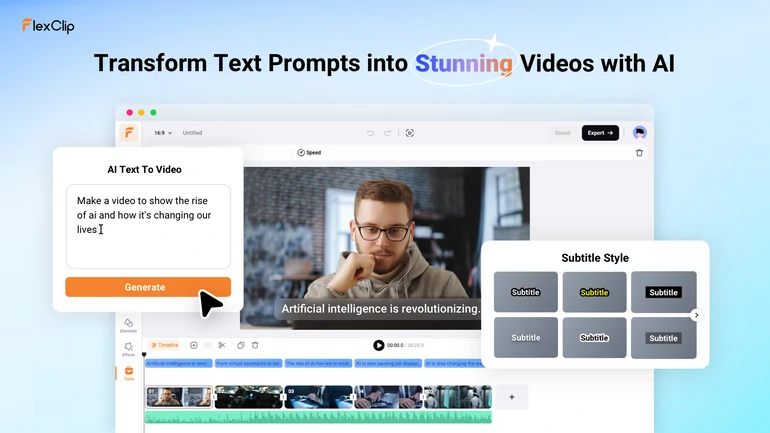
FlexClip Text to Video Overview
Here are more FlexClip can help out:
- Generate excellent text essays with ChatGPT. Tell FlexClip the theme of the video essay, you will get the best-ever AI essay script perfect for video creation.
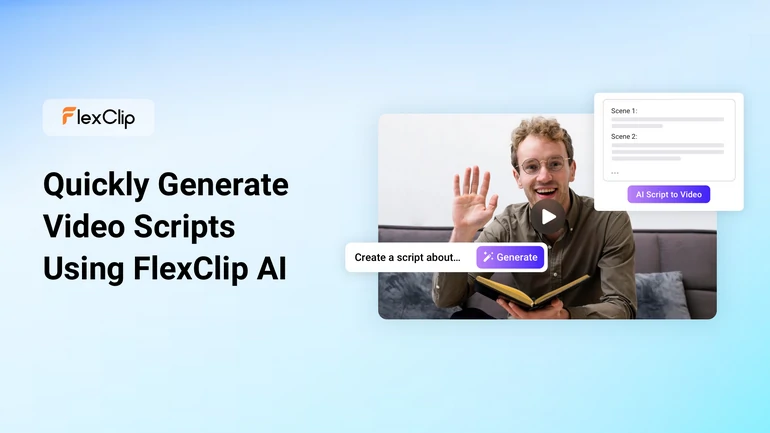
FlexClip Script Writer Overview
- Farewell to robotic AI voiceover. FlexClip’s AI text-to-speech tool reads out anything for you in a natural, melodious voice. 140+ language support, and 400 voices will certainly meet all your needs.
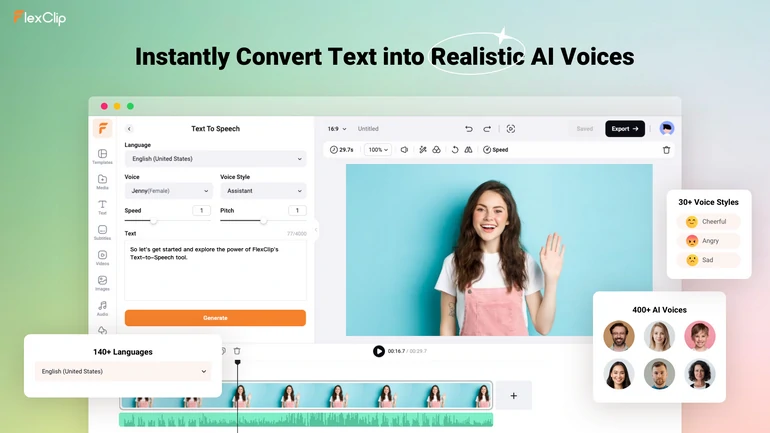
FlexClip Text to Speech Overview
- Authentically translate your video subtitle or voiceover into 60+ languages. Make your video go global and reach more audiences!
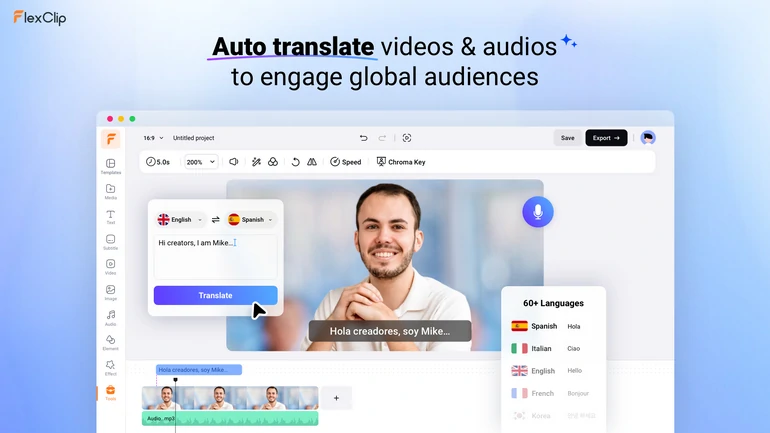
FlexClip Video Translate Overview
- Tons of video essay templates designed by professionals are ready to be edited and personalized. Go to FlexClip’s template page and get more inspiration.

5 Easy Steps to Make a Video Essay
If you are at FlexClip’s editing page, you are only 5 steps away from a satisfying video essay. Let’s get started now!
Step 1. Preparation
Getting organized always makes you more effective, the same applies to video essay creation. You need to put all media resources like music, photos, video clips in one folder.
Do remember to summarize your text essay into a bullet list. Anyway, video essays are not all about details, but about making ideas more digestible.
Next up, visit FlexClip’s media section, click on the Upload files button, and follow the prompt to upload all photos, videos, music from a local folder, cloud services, and mobile device needed for video essay creation.
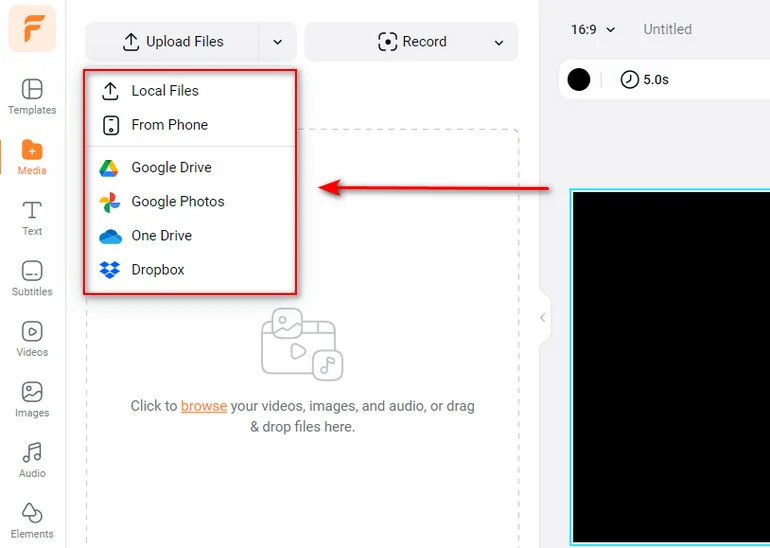
Upload Resources to FlexClip
Step 2. Generate a Video Essay Draft
Once you input your text essay, FlexClip can understand the content, match the content with resources from the stock library, and then use them to create a slideshow. AI will add transitions and filters to those media resources to make everything go smoothly.
Go to Tools > AI Video Generator. Here you can enter a prompt to generate a video, or generate videos from an article or URL. Copy the article content or blog URL to FlexClip, select the subtitle style and hit Generate.
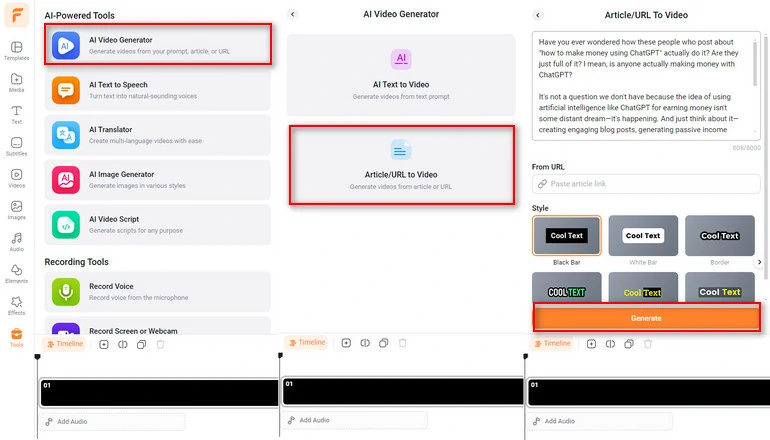
Generate a Video with Text
FlexClip will automatically find the key sentences from the article and match them with media resources. You can deselect or re-select the key sentences, replace the resources, adjust the duration, even manually edit the subtitle content. Hit Add to Timeline to confirm all changes.
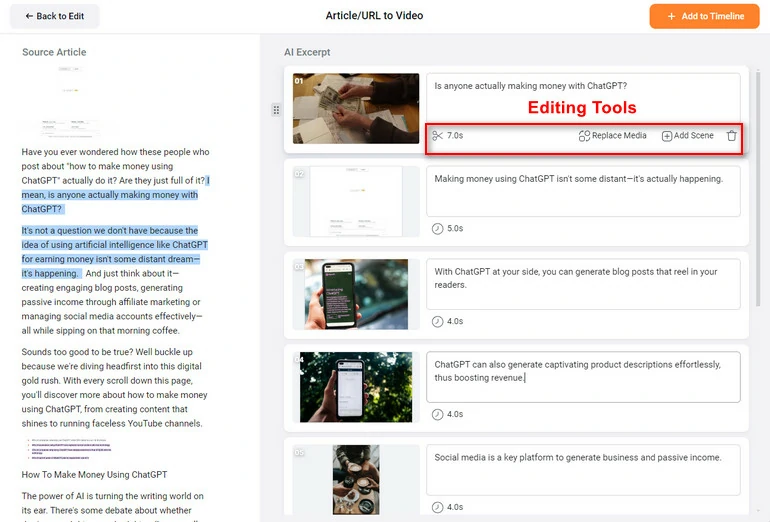
Finish Video Essay Draft
Step 3. Edit the Video Essay
As we mentioned earlier, the AI text-to-video tool only creates a draft video essay. To make your video essay outstanding, you have to make some manual edits. Here are some ideas to edit your video essay.
Click on any item on the scene, all available editing tools will pop up above the preview window. The most frequently used tools include cropping, speed changer, filters, chroma key.
Instead, move to the text section to add more information, find the right background music to replace, or go to the Elements section to enrich your video essay with stickers, interesting GIFs, widgets, etc. All resources are listed on the left-side panel. Feel free to explore.
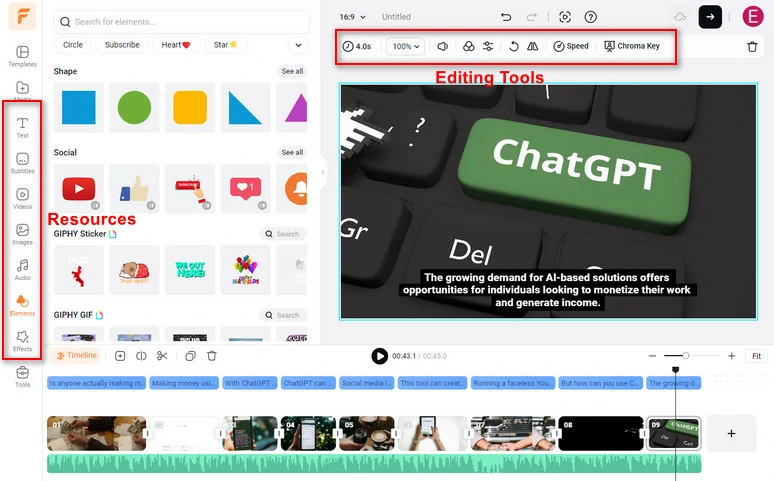
Edit Video Essay
Step 4. Add More AI Touches
Voiceover is an essential part of the video essay. You can record your own voice, but why not grab a cup of coffee and let AI do the job? Select the language, choose a voice, and the voice style you love, set up the speed and pitch, you will soon get a natural AI voiceover.
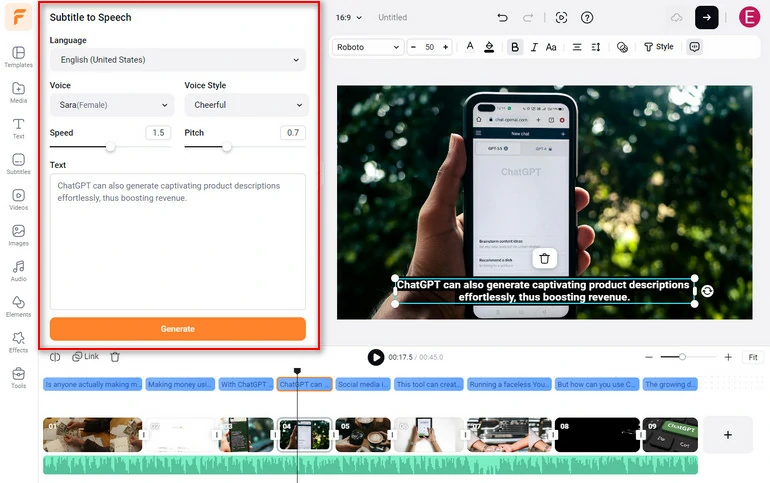
Generate AI Voiceover
Make your video essay go global with authentic translation! FlexClip can help you translate video essay subtitles, translate video audio to audio, and even project text into 60 more languages. Select the target language and let translation begin.
Generate AI Translation
Step 5. Export & Share
Enjoy the ultimate freedom of sharing your video essay at FlexClip. Besides directly downloading to your computer, you can also save the video to cloud services, share the video via a short link, or one-click post to YouTube, TikTok.
Tips for Creating an Excellent Video Essay
Never created one video essay before? Following are 3 must-read tips for making excellent video essays.
- Write Eye-Catching & Strong Video Script
The script is the backbone of your video essay. You should pick a nice topic to make sure you have enough potential viewers, and do thorough research so that your script is trustworthy.
Start with a hook to grab your audience’s attention. Use storytelling techniques and concise sentences to keep them engaged throughout the video.
- High-Quality Footage and Images
Incorporate relevant and high-quality visuals that complement your script. Use original footage, stock footage, and public domain images where applicable at least in 1080P.
Most people will ignore the sound quality. Invest in a quiet environment and a good microphone to minimize background noise. Also, edit your audio to remove any mistakes and pauses.
- Edit for Pacing and Clarity
Edit your video essay to maintain a good pace and ensure clarity. Avoid long, unbroken segments of talking. Instead, use cuts, transitions, and visual changes to keep the audience engaged. You can also edit the video to the music beat.
Frequently Asked Questions
1. what’s the difference between vlog and video essay.
Vlogs are videos showcasing someone’s daily life. Video essays are more like essays in video form. They are used to convey excellent messages and spread information.
2. Can I monetize my video essays?
Yes, you can monetize your video essay through platforms like YouTube by enabling ads, partner programs, offering premium content. Please refer to the social platform’s monetizing policies and guidelines.
3. How do I write a script for a video essay?
Writing a script for a video essay involves extracting the main points from the essay and making it more like spoken sentences. Please keep in mind that the text should accompany the voiceover.

Member of PearlMountain Limited. Has a mania for video editing. Love to share photo/video shooting tips and ideas.
FlexClip Video Maker
The easiest way to help you create custom videos, no design skills needed.
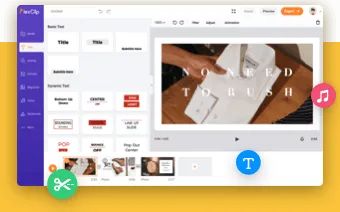
Hot & Trending
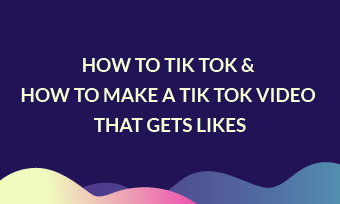
Ultimate Tik Tok Guide – How to Tik Tok & How to Make a Tik Tok Video that Gets Likes
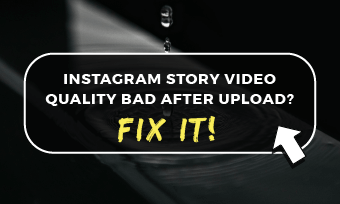
Instagram Story Video Quality Bad After Upload? Fix It!

How to Repost Video on TikTok & How to Remove TikTok Repost
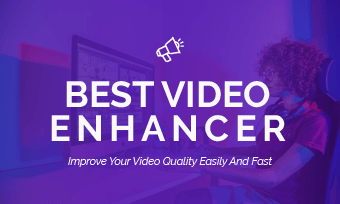
Improve Video Quality Online: 3 AI Video Quality Enhancers You Can't Miss

4K Convert to HD 1080p without Watermark: Best 4k Video Converters

How to Change Face in Video on Phone/Desktop/Online
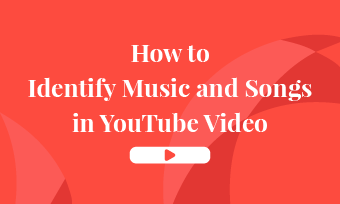
7 Best Ways to Find Music in YouTube Videos
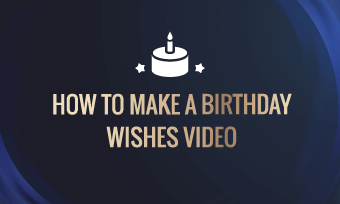
Top 13 Birthday Video Makers with Music and Effects Free
You May Also Be Interested

5 Video Compressor for WhatsApp: Compress & Reduce Videos Size for WhatsApp

Time Photos on TikTok: How to Edit Duration of Photos on TikTok on Phone


The Audiovisual Essay
Practice and Theory in Videographic Film and Moving Image Studies
HOW-TO VIDEO ESSAYS by Greer Fyfe and Miriam Ross
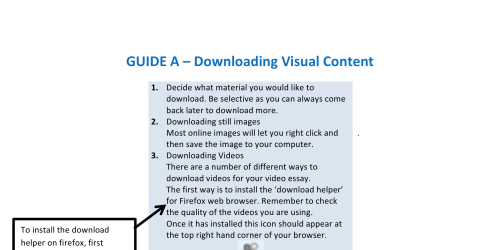
HOW-TO VIDEO ESSAYS
By Greer Fyfe and Miriam Ross
If you have never done any video work before it may seem intimidating at first but you will find it easier than you think if you work through the following steps. Seek help if you get stuck (Google is often a quick solution).
Getting started
- Ideally just one sentence;
- Write this down, keep referring to it and don’t be afraid of modifying it as you go through the whole process.
- voice-over ( https://vimeo.com/96558506 )?
- text+image ( http://vimeo.com/28201216 )?
- supercut ( https://vimeo.com/88077122 )?
- Don’t try to create something too complicated. Start with simple ideas and gather limited material at the beginning until you are confident that you can add more.
- https://www.youtube.com/watch?v=o47Lr9GXEnI
- https://vimeo.com/album/3198467
- http://vimeo.com/groups/essay
- http://framescinemajournal.com/article/video-essays-in-the-cinema-history-classroom/
- http://festivalists.com/post/110533801961/videoessay
- http://mediacommons.futureofthebook.org/intransition/
- https://reframe.sussex.ac.uk/audiovisualessay/
Collecting material
- Remember not to go overboard at the beginning as it is easy to download multiple files. Think about what you need to start the project and add more later.
- There are some online guides to ripping DVDs using readily available software: http://lifehacker.com/380702/five-best-dvd-ripping-tools ; http://www.howtogeek.com/howto/2696/how-to-rip-dvds-with-vlc/
- This can be a tricky area, particularly as some DVDs with greater level of encryption might be harder to rip than others. If you are not confident in this area stick to the other options for gathering material.
- Try to cut down ripped files into sections that you will need. If not you will be working with very big files that may overload your editing software.
- If you can play a film on your computer then you can grab still images from it.
- On a PC. Press PrtScn and then find somewhere you want to paste the image (ie. image editing software). Press Ctrl+V. If you have captured the whole computer screen you may need to crop the image.
- On a Mac. Press Command+Shift+3. This will save the image to your desktop. If you have captured the whole computer screen you may need to crop the image.
- If you don’t have a microphone available, look at your phones and your computer to see if they have a voice/sound recording option.
- Think about who will provide the voice. Make sure whoever does so is comfortable with their voice being used in this way.
- One DIY solution is to use your phone to film material when it plays on a TV or other device. This will create low quality images but is an option if all else fails.
- Use your academic skills to find quotes, factual statements and citations you might incorporate
- Although the footage and images you are working with don’t have to be HD, they should be clearly visible when blown up to full screen size
- When working in groups decide who is gathering what material and make sure this workload is distributed evenly.
- Some of this material will take up a lot of space. Make sure you have designated folders available, that you label your material carefully so you know what it is and that you have a plan for backing-up this work.
Editing material
- If you have not used this editing software before, familiarise yourself with it and do a short practice run.
- If you are familiar with other editing software you can use it.
- Feel free to experiment with split screens, diagrams and text but don’t over do it.
- If you are including a voice over you will need to decide if you do the voice over first and edit the visual material to match the voice over or if you organise the visual material first and then create a voice-over to match it. Neither way is better than the other and there will be some to and fro between the two options.
- Include a bibliography/filmography of sources used at the end of the video
- If this is an academic piece that will be assessed in an academic context aim for a formal rather than colloquial/funny style.
Post-first draft
- Add colour filters
- Swap a voice-over for text screens and vice-versa
- Return to your original argument. Have you made a clear and obvious argument in the video essay?
- Test playback. Check the video will play okay on different computers/television screens.
The How-to Guides as PDFs
- GUIDE A: Downloading Audiovisual Content
- GUIDE B: Editing your Own Content
- GUIDE C: Creating a Mash Up
- GUIDE D: Sharing your Work
- GUIDE E: Extra Software
- How-to Video Essays [as PDF]
Copyright information
The above and linked to information, where it pertains to the use of copyright material, is shared under the understanding that Fair Use or Fair Dealing legal exceptions are generally established—for educational, critical and private research purposes—in many, if not all, national jurisdictions. These exceptions have also been supported and successfully defended by a number of prominent professional academic associations including the Society for Cinema and Media Studies . Readers or users of this information will need to ensure for themselves that they obey the laws of the legal territories in which they live. Neither the authors nor REFRAME , University of Sussex, will accept any liability for actions readers or users freely choose to take.
The authors and copyright holders of the above text and linked PDFs— Greer Fyfe and Miriam Ross —have shared their work under a Creative Commons Attribution-ShareAlike licence. CC BY-SA. February 2015.
- TEXT: Greer Fyfe and Miriam Ross
- GUIDE Design: Greer Fyfe
Biographical Note
Miriam Ross is Senior Lecturer in the Film Programme at Victoria University of Wellington. She is the author of South American Cinematic Culture: Policy, Production, Distribution and Exhibition (2010) and 3D Cinema: Optical Illusions and Tactile Experiences (2015).
Greer Fyfe is a Research Assistant at Victoria University of Wellington.
Share this:

Step By Step Guide to Writing an Essay on Film
By Film Threat Staff | December 29, 2021
Writing an essay about a film sounds like a fun assignment to do. As part of the assignment, you get to watch the movie and write an analytical essay about your impressions. However, you will soon find that you’re staring at an empty sheet of paper or computer screen with no idea what to write, how to start writing your essay, or the essential points that need to be covered and analyzed. As an essay writing service proves, watching the movie countless times isn’t all there is to write a film analysis essay. Here’s a step-by-step guide to help you with an essay service :

1. Watch the Movie
This is the obvious starting point, but surprisingly many students skip this step. It doesn’t matter if you’ve watched the movie twice before. If you’re asked to write an essay about it, you need to watch it again. Watching the film again allows you to pay more attention to specific elements to help you write an in-depth analysis about it.
Watching the movie is crucial because it helps you not specific parts of the movie that can be used as illustrations and examples in your essay. You’re also going to explore and analyze the movie theme within your structured plan. Some of the critical elements that you have to look out for while watching the movie that may be crucial for your essay are:
- Key plot moments
- Editing style
- Stylistic elements
- Scenario execution
- Musical elements
2. Introduction
Your introduction will contain essential information about the film, such as the title, release date, director’s name, etc. This familiarizes the reader with the movie’s primary background information. In addition, researching the filmmaker may be crucial for your essay because it may help you discover valuable insights for your film analysis.
The introduction should also mention the movie’s central theme and explain why you think it was made that way.
Do not forget to include your thesis statement, which explains your focus on the movie.
3. Write a Summary
According to an essay writing service providing students help with essays , a movie summary comes after the introduction. It includes the film’s basic premise, but it doesn’t have to reveal too many details about the film. It’s a summary, after all. Write the summary like your readers have not heard about the movie before, so you can mention the most basic plots but assume you have minimal time so you won’t be going into great details.

4. Write Your Analysis
This is the central part of the essay in which you analyze the movie critically and state your impressions about the film. Ensure to support your claims with relevant materials from the movie.
There are also several creative elements in a movie that are connected to make the film a whole. You must pay attention to these elements while watching the movie and analyze them in this part of the essay.
In this, you are looking out for the dialogs, character development, completion of scenes, and logical event sequences in the film to analyze.
Ensure you try to understand the logic behind events in the film and the actor’s motives to explain the scenario better.
The responsibility of different parts of the movie, such as plan selection and scenario execution, falls on the director. So, your analysis here focuses on how the director realized the script compared to his other movies. Understanding the director’s style of directing may be crucial to coming up with a conclusion relevant to your analysis and thesis.
The casting of a film is a significant element to consider in your essay. Without a great actor, the scriptwriter and director can’t bring their ideas to life. So, watch the actor’s acting and determine if they portrayed the character effectively and if their acting aligns with the film’s main idea.
- Musical element
A movie’s musical element enhances some of the sceneries or actions in the film and sets the mood. It has a massive impact on the movie, so it’s an essential element to analyze in your essay.
- Visual elements
This includes special effects, make-up, costumes, etc., which significantly impact the film. These elements must reflect the film’s atmosphere. It is even more crucial for historical movies since it has to be specific about an era.
Ensure to analyze elements relevant to your thesis statement, so you don’t drift from your main point.
5. Conclusion
In concluding your essay, you have to summarize the primary concepts more convincingly to support your analysis. Finally, you may include a CTA for readers to watch or avoid the movie.
These are the crucial steps to take when writing an essay about a film . Knowing this beforehand prevents you from struggling to start writing after watching the movie.
Leave a Reply Cancel reply
Your email address will not be published. Required fields are marked *
Save my name, email, and website in this browser for the next time I comment.
… [Trackback]
[…] Find More Info here to that Topic: filmthreat.com/features/step-by-step-guide-to-writing-an-essay-on-film/ […]
[…] Read More: filmthreat.com/features/step-by-step-guide-to-writing-an-essay-on-film/ […]
It’s really amazing instructions! I have got the great knowledge.
[…] now and then. Unfortunately, not all of us can afford to get cinema tickets to do so. Some…Writing an essay about a film sounds like a fun assignment to do. As part of the assignment, you get…Since a few decades the film and entertainment sector have undergone some drastic transformation. […]
I can’t list the number of essays that don’t follow this format in the least. But then I find most reviews of movies terrible and most people who purport themselves to be writers as people who need to spend more time drafting and editing before publishing.
Thanks for this

Is Movie Streaming the Next Step for NFT?
Since a few decades the film and entertainment sector have undergone some drastic transformation. The first ever format to bring movies in the household...

How To Get A New Netflix Series On Your Subscription?
There are also some problems in getting new Netflix series on your subscription because of geo-restriction. If you are not in the USA then you still can't...

Amazing CBD Movies And TV Shows To Enjoy On Weekends
Most avid consumers of CBD attribute their love for it to cinemas and movies. The media always adds a touch of pizzazz to all that has to do with various...

8 Steps to Enjoy a Boring Movie
Sometimes, movies can be boring. Maybe your spouse dragged you to the theatres to watch a romantic comedy that made you fall asleep? Or maybe you went on a...

What Can We Learn from Netflix’s All-Time Top 10 movies?
Our excitement for the weekend never fades, and we begin making plans from the weekdays. Weekdays are too busy to relax and watch Netflix, so the weekends...

Where to Get Your Fill of Fantasy
Reality can be incredible, but nothing beats the feeling of stepping into a new world filled with magic, mystery, and excitement. We all need a break from...

Join our Film Threat Newsletter

What Is a Video Essay? Definition & Examples Of Video Essays
A video essay consists of a series of videos that collectively, present an in-depth analysis or interpretation of a given subject or topic.
In this way, a video essay can be thought of as a condensed version of a lengthy written article.
VIDEO ESSAY
What is a video essay.
A video essay is an audio-visual presentation of your thoughts on a topic or text that usually lasts between 5 and 10 minutes long.
It can take the form of any type of media such as film, animation, or even PowerPoint presentations.
The most important thing to remember when creating a video essay is to include voiceover narration throughout the whole project so that viewers feel they are listening in on your thoughts and ideas rather than watching passively.
Video essays are typically created by content creators’ critics to make arguments about cinema, television, art history, and culture more broadly.
Ever wondered how ideas unfold in the dynamic world of video?
That’s where video essays come in.
They’re a compelling blend of documentary and personal reflection, packed into a visually engaging package.
We’ll dive deep into the art of the video essay, a form that’s taken the internet by storm.
In this article, we’ll explore how video essays have revolutionized storytelling and education.
They’re not just a person talking to a camera; they’re a meticulously crafted narrative, often weaving together film footage, voiceover, text, and music to argue and inform.

Stick with us as we unpack the nuances that make video essays a unique and powerful medium for expression and learning.
Components Of A Video Essay
As storytellers and educators, we recognize the intricate elements that comprise a video essay.
Each component is vital for communicating the essay’s message and maintaining the audience’s engagement.
Narrative Structure serves as the backbone of a video essay.
Our crafting of this structure relies on a cinematic approach where the beginning, middle, and end serve to introduce, argue, and explore our ideas.
Film Footage then breathes life into our words.
We handpick scenes from various sources, be it iconic or obscure, to visually accentuate our narrative.
The Voiceover we provide acts as a guide for our viewers.
It delivers our analysis and commentary, ensuring our perspective is heard.

Paired with this is the Text and Graphics segment, offering another layer of interpretation.
We animate bullet points, overlay subtitles, and incorporate infographics to highlight key points.
Our sound design, specifically the Music and Sound Effects , creates the video essay’s atmosphere.
It underscores the emotions we wish to evoke and punctuates the points we make.
This auditory component is as crucial as the visual, as it can completely change the viewer’s experience.
We also pay close attention to the Editing and Pacing .
This ensures our video essays are not only informative but also engaging.
The rhythm of the cuts and transitions keeps viewers invested from start to finish.
In essence, a strong video essay is a tapestry woven with:
- Narrative Structure – the story’s framework,
- Film Footage – visual evidence supporting our claims,
- Voiceover – our distinctive voice that narrates the essay,
- Text and Graphics – the clarity of our arguments through visual aids,
- Music and Sound Effects – the emotive undercurrent of our piece,
- Editing and Pacing – the flow that maintains engagement.
Each element works Along with the others, making our video essays not just informative, but also a cinematic experience.
Through these components, we offer a comprehensive yet compelling way of storytelling that captivates and educates our audience.
The Power Of Visual Storytelling
Visual storytelling harnesses the innate human attraction to imagery and narrative.
At its core, a video essay is a compelling form of visual storytelling that combines the rich tradition of oral narrative with the dynamic appeal of cinema.
The impact of visual storytelling in video essays can be profound.

When crafted effectively, they engage viewers on multiple sensory levels – not just audibly but visually, leading to a more immersive and memorable experience.
Imagery in visual storytelling isn’t merely decorative.
It’s a crucial carrier of thematic content, enhancing the narrative and supporting the overarching message.
By incorporating film footage and stills, video essays create a tapestry of visuals that resonate with viewers.
- Film Footage – Brings concepts to life with cinematic flair,
- Stills and Graphics – Emphasize key points and add depth to the narrative.
Through the deliberate choice of images and juxtaposition, video essays are able to articulate complex ideas.
They elicit emotions and evoke reactions that pure text or speech cannot match.
From documentaries like An Inconvenient Truth to educational content on platforms like TED-Ed, video essays have proven their capacity to inform and inspire.
Sound design in video essays goes beyond mere accompaniment; it’s an integral component of storytelling.
Music and sound effects set the tone, heighten tension, and can even alter the audience’s perception of the visuals.
It’s this synergy that elevates the story, giving it texture and nuance.
- Music – Sets the emotional tone,
- Sound Effects – Enhances the realism of the visuals.
Crafting a narrative in this medium isn’t just about what’s on screen.
It requires an understanding of how each element – from script to sound – works in concert.
This unity forms an intricate dance of auditory and visual elements that can transform a simple message into a powerful narrative experience.
The Influence Of Video Essays In Education
Video essays have become a dynamic tool in academic settings, transcending traditional teaching methods.
By blending entertainment with education, they engage students in ways that lectures and textbooks alone cannot.

How To Create A Powerful Video Essay
Creating a compelling video essay isn’t just about stitching clips together.
It requires a blend of critical thinking, storytelling, and technical skill.
Choose a Central Thesis that resonates with your intended audience.
Like any persuasive essay, your video should have a clear argument or point of view that you aim to get across.
Research Thoroughly to support your thesis with factual data and thought-provoking insights.
Whether you’re dissecting themes in The Great Gatsby or examining the cinematography of Citizen Kane , your analysis must be thorough and well-founded.
Plan Your Narrative Structure before jumping into the editing process.
Decide the flow of your argument and how each segment supports your central message.
Typically, you’d include:
- An intriguing introduction – set the stage for what’s coming,
- A body that elaborates your thesis – present your evidence and arguments,
- Clearly separated sections – these act as paragraphs would in written essays.
Visuals Are Key in a video essay.
We opt for high-quality footage that not only illustrates but also enhances our narrative.
Think of visuals as examples that will bring your argument to life.
Audio selection Should Never Be an Afterthought.
Pair your visuals with a soundtrack that complements the mood you’re aiming to create.
Voice-overs should be clear and paced in a way that’s easy for the audience to follow.
Editing Is Where It All Comes Together.
Here, timing and rhythm are crucial to maintain viewer engagement.
We ensure our cuts are clean and purposeful, and transition effects are used judiciously.
Interactive Elements like on-screen text or graphics can add a layer of depth to your video essay.

Use such elements to highlight important points or data without disrupting the flow of your narrative.
Feedback Is Invaluable before finalizing your video essay.
We often share our drafts with a trusted group to gain insights that we might have missed.
It’s a part of refining our work to make sure it’s as impactful as it can be.
Remember, creating a video essay is about more than compiling clips and sound – it’s a form of expression that combines film criticism with visual storytelling.
It’s about crafting an experience that informs and intrigues, compelling the viewer to see a subject through a new lens.
With the right approach, we’re not just delivering information; we’re creating an immersive narrative experience.
What Is A Video Essay – Wrap Up
We’ve explored the intricate craft of video essays, shedding light on their ability to captivate and inform.
By weaving together compelling visuals and sound with a strong narrative, we can create immersive experiences that resonate with our audience.
Let’s harness these tools and share our stories, knowing that with the right approach, our video essays can truly make an impact.
Remember, it’s our unique perspective and creative vision that will set our work apart in the ever-evolving landscape of digital storytelling.
Frequently Asked Questions
What is visual storytelling in video essays.
Visual storytelling in video essays is the craft of using visual elements to narrate a story or present an argument, engaging viewers on a sensory level beyond just text or speech.
Why Is Visual Storytelling Important In Video Essays?
Visual storytelling is important because it captures attention and immerses the audience, making the content more memorable and impactful through the integration of visuals, sound, and narrative.
What Are The Key Elements Of A Powerful Video Essay?
The key elements include a central thesis, thorough research, a well-planned narrative structure, high-quality visuals, fitting audio, effective editing, interactive components, and a compelling immersive narrative experience.
How Do I Choose A Central Thesis For My Video Essay?
Choose a central thesis that is focused, debatable, and thought-provoking to anchor your video essay and give it a clear direction.
What Should I Focus On During The Research Phase?
Focus on gathering varied and credible information that supports your thesis and enriches the narrative with compelling facts and insights.
What Role Does Audio Play In Video Essays?
Audio enhances the visual experience by adding depth to the narrative, providing emotional cues, and aiding in information retention.
How Can Interactive Elements Improve My Video Essay?
Interactive elements can enhance engagement by allowing viewers to participate actively, often leading to a deeper understanding and connection with the content.
Why Is Feedback Important In Creating A Video Essay?
Feedback is crucial as it provides insights into how your video essay is perceived, allowing you to make adjustments to improve clarity, impact, and viewer experience.
Buying Electronics Online - How to Not Get Scammed
What Is a Prime Lens? Learn About This Crucial Lens
Matt Crawford
Related posts, what is letterboxing in film: framing the visual story [complete guide], how to write a press release: complete step by step guide, what is natural horror: the terrifying beauty of nature unleashed, ideas for short films: how to concept a short film in 8 steps, the best of filmmaking & video production july 2017, transgender in film: exploring representation and its impact on society.
A video essay is a type of video that is used to present a single, cohesive argument or idea. They can be used to communicate a complex idea in a way that is easy to understand. They can also be used to show how a
It is indeed.
Absolutely, Greg.
Great post! I found the definition of video essays to be particularly insightful.
As someone who is new to the world of video essays, it’s helpful to understand the different forms and purposes of this medium. The examples you provided were also enlightening, particularly the one on the First Amendment.
I’m looking forward to exploring more video essays in the future!
I found this post to be incredibly informative and helpful in understanding the concept of video essays.
As a budding filmmaker, I’m intrigued by the idea of blending traditional essay structure with visual storytelling. The examples provided in the post were particularly insightful, showcasing the versatility of video essays in capturing complex ideas and emotions. I can’t wait to explore this medium further and see where it takes me!
I found this post really fascinating, especially the section on the different types of video essays. I never knew there were so many variations!
As a student, I’m definitely going to start experimenting with video essays as a way to express myself and communicate my ideas. Thanks for sharing!
Interesting read! I’m curious to explore more video essays and see how they can be used to convey complex ideas in an engaging way.
Appreciate the comment
Leave a Reply Cancel reply
This site uses Akismet to reduce spam. Learn how your comment data is processed .
Username or Email Address
Remember Me
Registration is closed.
Pin It on Pinterest

WANT GET MORE CLIENTS & GROW YOUR VIDEO COMPANY TO 7-FIGURES PER YEAR?
Enter Your Details Below!
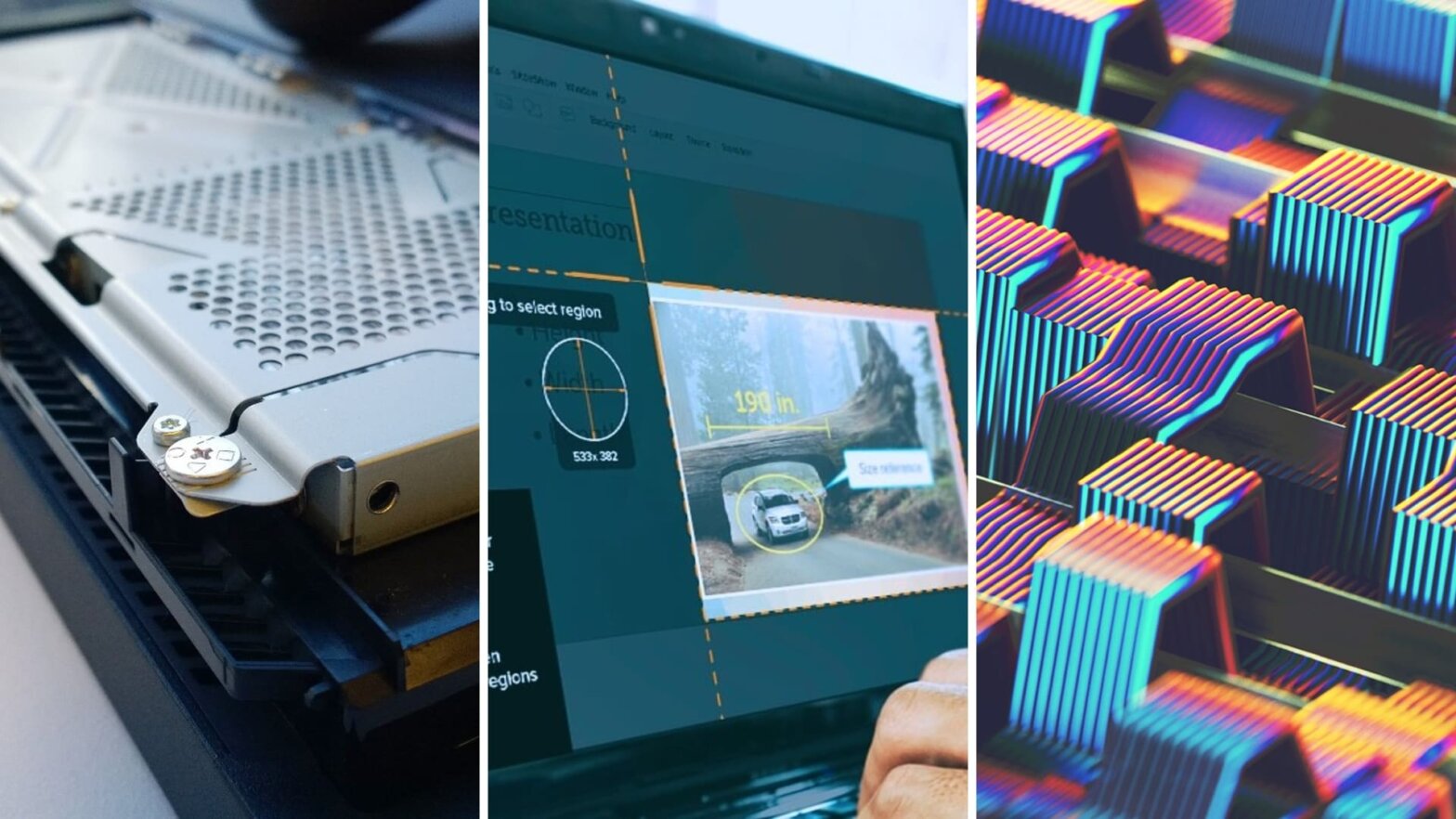
- Post-Production
How to Get Clips for Edits — 4 Ways to Capture Footage Online
H ow do you get movie clips to use in editing projects? There are a few different reasons why you may need pre-existing movie footage brought into your editing program of choice. Perhaps you are putting together YouTube content such as video essays or movie reviews and you need clips of the source material, or maybe you need footage to learn how to edit or to practice with. Whatever your needs may be, there are a few different ways one can go about sourcing movie footage. We will run through each viable method.
Fair Use Explained • Clips to use for edits
YouTube video styles that would be protected by Fair Use copyright law include things like movie reviews and video essays . For more on video essays, be sure to watch our recap of StudioBinder’s best video essays of 2020.
The best video essays of 2020 • Subscribe on YouTube
The first step is to figure out exactly what footage you need in order to carry out your desired edit. Determine which clips or scenes you will need or if you will need the entire film to edit with. Gathering individual clips may be slightly easier than pulling all of the footage from an entire film but both are possible.
Once you have decided on the specific footage that you need, you can move on to one of the four possible options for pulling movie clips detailed below.
Where To Find Clips For Video Edits
Option 1: youtube.
You will not likely be able to pull entire films from YouTube, but if you only need certain clips or scenes, there is a decent chance that the footage in question may already be uploaded to YouTube. The platform itself does not offer a feature to download videos from the site, but there are various methods with which this can be accomplished.
Websites like Keepvid.com and many others were built to download YouTube videos. Find your desired clip on YouTube, grab the share link, and paste it into one of these YouTube-downloader websites, and you will be presented with download links.
There are also browser extensions and plugins available that will enable you to download right from the video page on YouTube. And, lastly, there are also downloadable applications such as 4K Video Downloader that can be used to download YouTube videos.
This method involves installing the 4K Video Downloader onto your computer, then pasting links to whichever footage you need downloaded, and letting the application do the rest.
How To Get TV Show Clips For Edits
Option 2: screen capture.
Screen capture and screen recording methods can be used to acquire movie footage to edit with. You may encounter some difficulty using this method depending on where you go to source the desired footage. Some streaming platforms, such as Netflix, have measures in place to block screen recording efforts as an anti-piracy measure.
If you attempt to screen record on Netflix, your recording will appear to show nothing but a black screen. Not all streaming services have these measures in place, and some screen-recording programs attempt to bypass this type of blocking countermeasure.
There are many ways to go about the capturing process itself. One of the easiest methods, which is also completely free, is to use Quicktime. Depending on the type of device you have, Quicktime may already be pre-loaded onto your computer. Quicktime features a built-in screen recording option.
By default, the Quicktime screen recording only captures the visuals on your screen, with no internal audio input, however, internal audio can be added to the capture using the method described in the video below.
How to add audio to Quicktime screen recording • How to get movie clips for youtube videos
Outside of Quicktime, there are many alternative options for screen-recording programs. Many of the alternatives are free but others do charge one-time or monthly fees. Also, be aware that certain screen-recording programs have been suspected of being scams or viruses, so be sure to conduct research into any program before you download it.
A physical option also exists for screen-recording: a capture card . A capture card can be a great way to source the movie footage you need for editing projects and it has a number of alternative uses as well. Be sure to look through our purchasing guide for capture cards before making a decision.
Related Posts
- Best Movies in the Public Domain →
- How Copyright-Free Music works →
- FREE: Create and share a production calendar online →
Where To Get Video Clips For Edits
Option 3: physical media ripping.
If you own the movie that you want footage from on DVD or Blu-ray, it is possible to rip the movie footage directly from the disc. Some physical media discs have built-in countermeasures against ripping for piracy prevention. But many DVD and Blu-ray ripping programs attempt to circumvent these countermeasures. The following video details the process of ripping a DVD onto your computer.
Howfinity explains how to rip a DVD • How to find movie clips for edits
To gather footage using this method, you will need a disc drive that reads either DVDs or Blu-rays, depending on which physical-media variety you have. The disc drive can be internal or external, it will not make a difference.
External disc drives made specifically for DVD ripping are available for purchase. But there are also ripper software programs that can carry out the task using any disc drive.
How to Find Videos for Edits
Option 4: direct file download.
If a direct file download is available for the film that you require footage from, this will likely be the easiest method and the one that will get you into the editing the quickest. A direct download of the movie file may be able to be brought directly into the video editing program of your choice, or it may require a conversion to a file type more easily readable by the editing software.
Adobe Media Encoder is a great tool for converting footage. The following video will tell you everything you need to know in order to get started with Media Encoder.
Adobe Media Encounter Guide • how to get tv show clips for edits
Whichever method you use to gather movie footage, always be sure that your use of copyrighted material is protected by Fair Use copyright law.
The Best Capture Cards on the Market
Those were a number of different ways to go about acquiring movie footage to use in your own editing projects. If the capture card method sounds appealing to you, then our rundown of the best capture cards available for purchase can help you make an informed decision when figuring out which capture card is best for your needs.
Up Next: Best Capture Cards →
Showcase your vision with elegant shot lists and storyboards..
Create robust and customizable shot lists. Upload images to make storyboards and slideshows.
Learn More ➜
- Pricing & Plans
- Product Updates
- Featured On
- StudioBinder Partners
- Ultimate Guide to Call Sheets
- How to Break Down a Script (with FREE Script Breakdown Sheet)
- The Only Shot List Template You Need — with Free Download
- Managing Your Film Budget Cashflow & PO Log (Free Template)
- A Better Film Crew List Template Booking Sheet
- Best Storyboard Softwares (with free Storyboard Templates)
- Movie Magic Scheduling
- Gorilla Software
- Storyboard That
A visual medium requires visual methods. Master the art of visual storytelling with our FREE video series on directing and filmmaking techniques.
We’re in a golden age of TV writing and development. More and more people are flocking to the small screen to find daily entertainment. So how can you break put from the pack and get your idea onto the small screen? We’re here to help.
- Making It: From Pre-Production to Screen
- What is a Femme Fatale — Definition, Characteristics, Examples
- What is Method Acting — 3 Different Types Explained
- How to Make a Mood Board — A Step-by-Step Guide
- What is a Mood Board — Definition, Examples & How They Work
- How to Make a Better Shooting Schedule with a Stripboard
- 4 Pinterest

4 Easy Steps On How To Make A Video Essay
Just like photo essays and traditional essays, video essays tell a story or make a point. The only difference is that it presents the information or story in video form.
However, how to make a video essay is a general question in today’s time. As the development of technology and easy access to the internet has changed the traditional method of narrating a story through written essays has to be video essays. It is quite easy to connect with people through videos as compared to written essays as you can attract them in both express and implied ways. It has risen as an effective and efficient mode of presenting the information.
Thus, this blog will help you understand how to make a video essay proficiently and the significance of making such an essay. Let’s start by discussing what a video essay is.
What is a video essay?
Table of Contents
The essay is a short formal piece of writing to express one’s thoughts, stories, arguments, and so on. Video essay means narrating the content of an essay in a video through pictures, text, music or narration, etc.
This is why it is a bit challenging to make a videos essay as compared to writing a traditional essay. Hence, the importance of learning how to make a video essay arises.
The following picture shows the steps that will help you get going with your project.
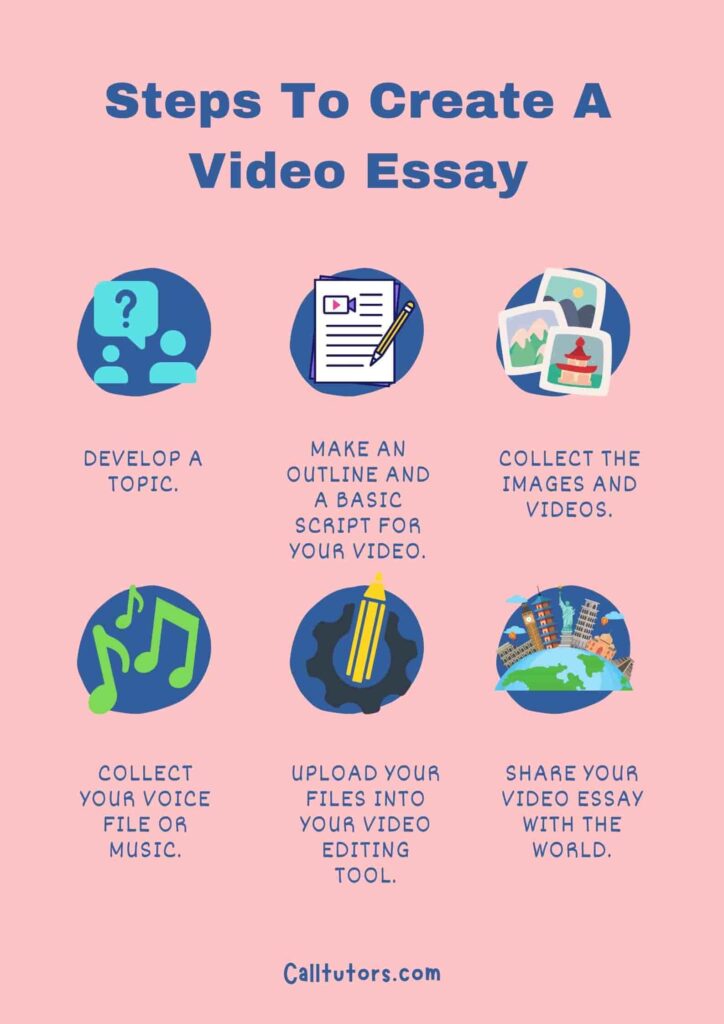
How to make a video essay?
Following are the steps involved in how to make a video essay:
1. Contemplate your topic wisely
- The first and the foremost step in how to make a video essay is to choose a topic for your essays. You can’t jump on to other steps before finalizing your topic. Your topic must address a brief content of the essay. Since it’s a videos essay therefore you have to decide a catchy title with a view to attract and allure your audience.
- While contemplating a topic for the essay you should always keep in mind that the product or content is the second thing but the title is the first thing to tell the audience about the essay.
2. Create a script and structure
- After deciding a topic now you have to create a story from your idea. Since video essays work as written essays, therefore you have to build a story on your idea in an interesting way.
- As in a written essay you have to build a structure and outline to present your story, likewise in a video essay you have to drive a video in three stages beginning, middle, and end.
- This step is very mandatory and has to be observed very cautiously. Create your narration or pictures, text beforehand so that you narrate the actual story in the perfect format.
- As soon as you will make your outline then you can write your script in an efficient and effective manner. Writing a story is an art so make it worth watching.
3. Decide the right clips and images
- By now you have decided your title, outline, and structure for your video essay. Now the next step in how to make a video essay is to choose the right clips and images to tell the story in the best manner.You can create clip by selecting the most relevant parts of your footage and trimming them down to fit your story’s pacing and structure. Additionally, consider using images that help illustrate your points or add visual interest to the video.
- Since this is the best advantage of a videos essay that you can use pictures and clips to share your views so you also have to make the best use of them accordingly.
- Always use only those pictures, clips, and texts which directly suggest your point of view or argument or your experience and so forth.
- To choose the most suitable clips and texts and images you must have a rich library of the same. The rich library will help you to find exactly what you need and want to support each and every point you make and to rebut the point you want to rebut. Conclusively, you will craft a better video.
4. Edit the video into a single essay
- You have everything ready to go and you are only left to collect and merge all the chosen images and footage into a single video to give it a form of narration.
- While editing your video essay you can use any tools related to editing the videos as there are several videos editing too . It will help you to garnish your video in an attractive manner. You can make changes in the video while remembering your targeted audiences.
How long should a video essay be?
A 10-minute video essay that is clear, focused, stylish, and well-crafted is much better than a 60-minute video essay that is loose, vague, obvious, and thrown together. Thus, concerning traditional written essays, the following are the idea of the expected length of a video essay:
| 1500-2000 words | 8-10 minutes |
| 2000-2500 words | 10-15 minutes |
| 4000-6000 words | 15-20 minutes |
Bonus Point
What are the best video editors.
Following are the best video editors that are free of cost:
(i) Lightworks: It is the best free choice for those who want to create professional-quality movies or videos without spending a penny.
(ii) Hitfilm express: It is also free-to-use video editing software. This software adjusts color balance, trim clips, and exports your projects in different video formats.
(iii) Movie Maker Online: It is a video editor that runs in your browser. to edit a video, you have to upload an unusual vertical project timeline where you can crop clops and add filters or transition effects.
(iiii) Canva: Canva is renowned for offering tens of thousands of templates in every format imaginable for use on every publishing platform. The features that make Canva video editor a fun, special, and effective tool include real-time collaboration, self-recording plus screen recording that is ideal for classes, training, and webinars, pre-licensed audio tracks, content planner, and publisher, as well as brand kit and colors. Canva’s video editor is also accessible on your browser (for online editing), desktop download (if you want offline editing), and mobile (iOS and Android).
(v) Vmaker AI: An easy-to-use AI video editor that turns your raw video footage into professional-looking videos in just one click. It automatically adds B-rolls, background music, transitions, effects, subtitles, intros, outros, and more, making your videos publish-ready with one click. Vmaker AI transforms long-form videos into short-form content and also creates highlights and teasers from your videos. What sets Vmaker AI apart is its feature-packed, full-fledged editing suite that lets the pros craft their videos to perfection.
If you are well versed with this blog, then sure, you know how to make a video essay efficiently and effectively.
Video Essay As Form Of Marketing
The video essay is the latest popular style of essay in which a short video is made to narrate a story or anything as per the genre of the essay. That is why it has emerged as an effective tool of marketing as now companies can sell advertises their products through video essays instead of advertisement videos. This is more efficient than traditional advertisements because it does not directly intend to do marketing. Instead, it depicts the importance of the product through pictures, video clips or story narration, etc. But all this is possible only when you know how to make a video essay.
Quick Links
- The Complete List Of Cause And Effect Essay Topics
- How To Write An Essay Plan?
With the emergence of technology and awareness of technology in people, the method of academics has completely changed and video essay is one of the modern aspects. In video essays, You can create clip by selecting the most relevant parts of your footage and trimming them down to fit your story’s pacing and structure. Additionally, consider using images that help illustrate your points or add visual interest to the video. It has also become a tool of digital marketing owing to its advantages. But all this is possible only when you know how to make video essays and all the guidelines thereto. It will help to make a good video essay.
Hope you have found out from the above information how to make a video essay, but if you still have any doubts, then you can help from our experts through essay writing help , write essay for me in a very short period, and how to write my essay in an easy way.
What Makes A Video Essay Great?
According to Max Marriner, intellectual accessibility, genuine or hard-hitting evidence, and an engaging host are key formulas for making a good video essay.
Who Made The First Video Essay?
Mathew Turner created a viral youtube essay arguing that Daniel LaRusso, the young hero of the 1984 film, The Karate Kid, was actually the movie’s villain. You first need to know the story behind the video he posted to youtube.
How Do You Structure A Video Essay?
The video essay will have the same features as an essay; an introduction, argument, discussion, and conclusion. Students should be enabled to approach the development of the video essay in the same way as their academic essays; research, write, plan, prepare, edit, and submit.
Similar Articles

13 Best Tips To Write An Assignment
Whenever the new semester starts, you will get a lot of assignment writing tasks. Now you enter the new academic…

How To Do Homework Fast – 11 Tips To Do Homework Fast
Homework is one of the most important parts that have to be done by students. It has been around for…
Leave a Comment Cancel Reply
Your email address will not be published. Required fields are marked *
This site uses Akismet to reduce spam. Learn how your comment data is processed .
How to Write a Film Analysis Essay: Examples, Outline, & Tips
A film analysis essay might be the most exciting assignment you have ever had! After all, who doesn’t love watching movies? You have your favorite movies, maybe something you watched years ago, perhaps a classic, or a documentary. Or your professor might assign a film for you to make a critical review. Regardless, you are totally up for watching a movie for a film analysis essay.
However, once you have watched the movie, facing the act of writing might knock the wind out of your sails because you might be wondering how to write a film analysis essay. In summary, writing movie analysis is not as difficult as it might seem, and Custom-writing.org experts will prove this. This guide will help you choose a topic for your movie analysis, make an outline, and write the text.️ Film analysis examples are added as a bonus! Just keep reading our advice on how to get started.
❓ What Is a Film Analysis Essay?
- 🚦 Film Analysis Types
📽️ Movie Analysis Format
✍️ how to write a film analysis, 🎦 film analysis template, 🎬 film analysis essay topics.
- 📄 Essay Examples
🔗 References
To put it simply, film analysis implies watching a movie and then considering its characteristics : genre, structure, contextual context, etc. Film analysis is usually considered to be a form of rhetorical analysis . The key to success here is to formulate a clear and logical argument, supporting it with examples.
🚦 Film Analysis Essay Types
Since a film analysis essay resembles literature analysis, it makes sense that there are several ways to do it. Its types are not limited to the ones described here. Moreover, you are free to combine the approaches in your essay as well. Since your writing reflects your own opinion, there is no universal way to do it.
- Semiotic analysis . If you’re using this approach, you are expected to interpret the film’s symbolism. You should look for any signs that may have a hidden meaning. Often, they reveal some character’s features. To make the task more manageable, you can try to find the objects or concepts that appear on the screen multiple times. What is the context they appear in? It might lead you to the hidden meaning of the symbols.
- Narrative structure analysis . This type is quite similar to a typical literature guide. It includes looking into the film’s themes, plot, and motives. The analysis aims to identify three main elements: setup, confrontation, and resolution. You should find out whether the film follows this structure and what effect it creates. It will make the narrative structure analysis essay if you write about the theme and characters’ motivations as well.
- Contextual analysis . Here, you would need to expand your perspective. Instead of focusing on inner elements, the contextual analysis looks at the time and place of the film’s creation. Therefore, you should work on studying the cultural context a lot. It can also be a good idea to mention the main socio-political issues of the time. You can even relate the film’s success to the director or producer and their career.
- Mise-en-scene analysis . This type of analysis works with the most distinctive feature of the movies, audiovisual elements. However, don’t forget that your task is not only to identify them but also to explain their importance. There are so many interconnected pieces of this puzzle: the light to create the mood, the props to show off characters’ personalities, messages hidden in the song lyrics.

To write an effective film analysis essay, it is important to follow specific format requirements that include the following:
- Standard essay structure. Just as with any essay, your analysis should consist of an introduction with a strong thesis statement, body paragraphs, and a conclusion. The main body usually includes a summary and an analysis of the movie’s elements.
- Present tense for events in the film. Use the present tense when describing everything that happens in the movie. This way, you can make smooth transitions between describing action and dialogue. It will also improve the overall narrative flow.
- Proper formatting of the film’s title. Don’t enclose the movie’s title in quotation marks; instead, italicize it. In addition, use the title case : that is, capitalize all major words.
- Proper use of the characters’ names. When you mention a film character for the first time, name the actor portraying them. After that, it is enough to write only the character’s name.
- In-text citations. Use in-text citations when describing certain scenes or shots from the movie. Format them according to your chosen citation style. If you use direct quotes, include the time-stamp range instead of page numbers. Here’s how it looks in the MLA format: (Smith 0:11:24–0:12:35).
Even though film analysis is similar to the literary one, you might still feel confused with where to begin. No need to worry; there are only a few additional steps you need to consider during the writing process.
| ✔️ | Reread the prompt twice! It’s crucial because your thesis statement and main arguments will be based on it. To help yourself at this stage, try an . It will make your efforts more productive. | |
| ✔️ | Take your time and watch the film as many times as you need so that you don’t miss anything. You might find it helpful to take notes or even use a screenplay if you can find one. | |
| ✔️ | You should write down a thesis statement and organize the main ideas. Don’t forget to support your arguments with evidence and make sure they align with the assignment requirements. | |
| ✔️ | The last step is writing the first draft of your essay. The text doesn’t necessarily have to be perfect since you still need to take some time to edit and to proofread it.In the next sections, there are more detailed descriptions of how to get every step done quickly. And remember that you can always ask your supervisor for help if you have any questions! |
Need more information? It can be found in the video below.
Starting Your Film Analysis Essay
There are several things you need to do before you start writing your film analysis paper. First and foremost, you have to watch the movie. Even if you have seen it a hundred times, you need to watch it again to make a good film analysis essay.
Note that you might be given an essay topic or have to think of it by yourself. If you are free to choose a topic for your film analysis essay, reading some critical reviews before you watch the film might be a good idea. By doing this in advance, you will already know what to look for when watching the movie.
In the process of watching, keep the following tips in mind:
- Consider your impression of the movie
- Enumerate memorable details
- Try to interpret the movie message in your way
- Search for the proof of your ideas (quotes from the film)
- Make comments on the plot, settings, and characters
- Draw parallels between the movie you are reviewing and some other movies
Making a Film Analysis Essay Outline
Once you have watched and possibly re-watched your assigned or chosen movie from an analytical point of view, you will need to create a movie analysis essay outline . The task is pretty straightforward: the outline can look just as if you were working on a literary analysis or an article analysis.
- Introduction : This includes the basics of the movie, including the title, director, and the date of release. You should also present the central theme or ideas in the movie and your thesis statement .
- Summary : This is where you take the time to present an overview of the primary concepts in the movie, including the five Ws (who, what, when, where, and why)—don’t forget how!—as well as anything you wish to discuss that relates to the point of view, style, and structure.
- Analysis : This is the body of the essay and includes your critical analysis of the movie, why you did or did not like it, and any supporting material from the film to support your views. It would help if you also discussed whether the director and writer of the movie achieved the goal they set out to achieve.
- Conclusion: This is where you can state your thesis again and provide a summary of the primary concepts in a new and more convincing manner, making a case for your analysis. You can also include a call-to-action that will invite the reader to watch the movie or avoid it entirely.
You can find a great critical analysis template at Thompson Rivers University website. In case you need more guidance on how to write an analytical paper, check out our article .
Writing & Editing Your Film Analysis Essay
We have already mentioned that there are differences between literary analysis and film analysis. They become especially important when one starts writing their film analysis essay.
First of all, the evidence you include to support the arguments is not the same. Instead of quoting the text, you might need to describe the audiovisual elements.
However, the practice of describing the events is similar in both types. You should always introduce a particular sequence in the present tense. If you want to use a piece of a dialogue between more than two film characters, you can use block quotes. However, since there are different ways to do it, confirm with your supervisor.
For your convenience, you might as well use the format of the script, for which you don’t have to use quotation marks:
ELSA: But she won’t remember I have powers?
KING: It’s for the best.
Finally, to show off your proficiency in the subject, look at the big picture. Instead of just presenting the main elements in your analysis, point out their significance. Describe the effect they make on the overall impression form the film. Moreover, you can dig deeper and suggest the reasons why such elements were used in a particular scene to show your expertise.
Stuck writing a film analysis essay? Worry not! Use our template to structure your movie analysis properly.
Introduction
- The title of the film is… [title]
- The director is… [director’s name] He/she is known for… [movies, style, etc.]
- The movie was released on… [release date]
- The themes of the movie are… [state the film’s central ideas]
- The film was made because… [state the reasons]
- The movie is… because… [your thesis statement].
- The main characters are… [characters’ names]
- The events take place in… [location]
- The movie is set in… [time period]
- The movie is about… [state what happens in the film and why]
- The movie left a… [bad, unforgettable, lasting, etc.] impression in me.
- The script has… [a logical sequence of events, interesting scenes, strong dialogues, character development, etc.]
- The actors portray their characters… [convincingly, with intensity, with varying degree of success, in a manner that feels unnatural, etc.]
- The soundtrack is [distracting, fitting, memorable, etc.]
- Visual elements such as… [costumes, special effects, etc.] make the film [impressive, more authentic, atmospheric, etc.]
- The film succeeds/doesn’t succeed in engaging the target audience because it… [tells a compelling story, features strong performances, is relevant, lacks focus, is unauthentic, etc.]
- Cultural and societal aspects make the film… [thought-provoking, relevant, insightful, problematic, polarizing, etc.]
- The director and writer achieved their goal because… [state the reasons]
- Overall, the film is… [state your opinion]
- I would/wouldn’t recommend watching the movie because… [state the reasons]
- Analysis of the film Inception by Christopher Nolan .
- Examine the rhetoric in the film The Red Balloon .
- Analyze the visual effects of Zhang Yimou’s movie Hero .
- Basic concepts of the film Interstellar by Christopher Nolan.
- The characteristic features of Federico Fellini’s movies.
- Analysis of the movie The Joker .
- The depiction of ethical issues in Damaged Care .
- Analyze the plot of the film Moneyball .
- Explore the persuasive techniques used in Henry V .
- Analyze the movie Killing Kennedy .
- Discuss the themes of the film Secret Window .
- Describe the role of audio and video effects in conveying the message of the documentary Life in Renaissance .
- Compare and analyze the films Midnight Cowboy and McCabe and Mrs. Miller .
- Analysis of the movie Rear Window .
- The message behind the film Split .
- Analyze the techniques used by Tim Burton in his movie Sleepy Hollow .
- The topic of children’s abuse and importance of trust in Joseph Sargent’s Sybil .
- Examine the themes and motives of the film Return to Paradise by Joseph Ruben.
- The issues of gender and traditions in the drama The Whale Rider.
- Analysis of the film Not Easily Broken by Duke Bill.
- The symbolism in R. Scott’s movie Thelma and Louise .
- The meaning of audiovisual effects in Citizen Kane .
- Analyze the main characters of The Girl with the Dragon Tattoo .
- Discuss the historical accuracy of the documentary The Civil War .
- Analysis of the movie Through a Glass Darkly .
- Explore the core idea of the comedy Get Out .
- The problem of artificial intelligence and human nature in Ex Machina .
- Three principles of suspense used in the drama The Fugitive .
- Examine the ideas Michael Bay promotes in Armageddon .
- Analyze the visual techniques used in Tenet by Christopher Nolan.
- Analysis of the movie The Green Mile .
- Discrimination and exclusion in the film The Higher Learning .
- The hidden meaning of the scenes in Blade Runner .
- Compare the social messages of the films West Side Story and Romeo + Juliet .
- Highlighting the problem of children’s mental health in the documentary Kids in Crisis .
- Discuss the ways Paul Haggis establishes the issue of racial biases in his movie Crash .
- Analyze the problem of moral choice in the film Gone Baby Gone .
- Analysis of the historical film Hacksaw Ridge .
- Explore the main themes of the film Mean Girls by Mark Walters .
- The importance of communication in the movie Juno .
- Describe the techniques the authors use to highlight the problems of society in Queen and Slim .
- Examine the significance of visual scenes in My Family/ Mi Familia .
- Analysis of the thriller Salt by Phillip Noyce.
- Analyze the message of Greg Berlanti’s film Love, Simon .
- Interpret the symbols of the film The Wizard of Oz (1939).
- Discuss the modern issues depicted in the film The Corporation .
- Moral lessons of Edward Zwick’s Blood Diamond .
- Analysis of the documentary Solitary Nation .
- Describe the audiovisual elements of the film Pride and Prejudice (2005) .
- The problem of toxic relationships in Malcolm and Marie .
📄 Film Analysis Examples
Below you’ll find two film analysis essay examples. Note that the full versions are downloadable for free!
Film Analysis Example #1: The Intouchables
Raising acute social problems in modern cinema is a common approach to draw the public’s attention to the specific issues and challenges of people facing crucial obstacles. As a film for review, The Intouchables by Oliver Nakache and Éric Toledano will be analyzed, and one of the themes raised in this movie is the daily struggle of the person with severe disabilities. This movie is a biographical drama with comedy elements. The Intouchables describes the routine life of a French millionaire who is confined to a wheelchair and forced to receive help from his servants. The acquaintance of the disabled person with a young and daring man from Parisian slums changes the lives of both radically. The film shows that for a person with disabilities, recognition as a full member of society is more important than sympathy and compassion, and this message expressed comically raises an essential problem of human loneliness.
Movie Analysis Example #2: Parasite
Parasite is a 2019 South Korean black comedy thriller movie directed by Bong Joon-ho and is the first film with a non-English script to win Best Picture at the Oscars in 2020. With its overwhelming plot and acting, this motion picture retains a long-lasting effect and some kind of shock. The class serves as a backbone and a primary objective of social commentary within the South Korean comedy/thriller (Kench, 2020). Every single element and detail in the movie, including the student’s stone, the contrasting architecture, family names, and characters’ behavior, contribute to the central topic of the universal problem of classism and wealth disparity. The 2020 Oscar-winning movie Parasite (2019) is a phenomenal cinematic portrayal and a critical message to modern society regarding the severe outcomes of the long-established inequalities within capitalism.
Want more examples? Check out this bonus list of 10 film analysis samples. They will help you gain even more inspiration.
- “Miss Representation” Documentary Film Analysis
- “The Patriot”: Historical Film Analysis
- “The Morning Guy” Film Analysis
- 2012′ by Roland Emmerich Film Analysis
- “The Crucible” (1996) Film Analysis
- The Aviator’ by Martin Scorsese Film Analysis
- The “Lions for Lambs” Film Analysis
- Bill Monroe – Father of Bluegrass Music Film Analysis
- Lord of the Rings’ and ‘Harry Potter’ Film Analysis
- Red Tails by George Lucas Film Analysis
Film Analysis Essay FAQ
- Watch the movie or read a detailed plot summary.
- Read others’ film reviews paying attention to details like key characters, movie scenes, background facts.
- Compose a list of ideas about what you’ve learned.
- Organize the selected ideas to create a body of the essay.
- Write an appropriate introduction and conclusion.
The benefits of analyzing a movie are numerous . You get a deeper understanding of the plot and its subtle aspects. You can also get emotional and aesthetic satisfaction. Film analysis enables one to feel like a movie connoisseur.
Here is a possible step by step scenario:
- Think about the general idea that the author probably wanted to convey.
- Consider how the idea was put across: what characters, movie scenes, and details helped in it.
- Study the broader context: the author’s other works, genre essentials, etc.
The definition might be: the process of interpreting a movie’s aspects. The movie is reviewed in terms of details creating the artistic value. A film analysis essay is a paper presenting such a review in a logically structured way.
- Film Analysis – UNC Writing Center
- Film Writing: Sample Analysis // Purdue Writing Lab
- Yale Film Analysis – Yale University
- Film Terms And Topics For Film Analysis And Writing
- Questions for Film Analysis (Washington University)
- Resources on Film Analysis – Cinema Studies (University of Toronto)
- Does Film Analysis Take the Magic out of Movies?
- Film Analysis Research Papers – Academia.edu
- What’s In a Film Analysis Essay? Medium
- Analysis of Film – SAGE Research Methods
- Share to Facebook
- Share to LinkedIn
- Share to email

A critique paper is an academic writing genre that summarizes and gives a critical evaluation of a concept or work. Or, to put it simply, it is no more than a summary and a critical analysis of a specific issue. This type of writing aims to evaluate the impact of...

What is a creative essay, if not the way to express yourself? Crafting such a paper is a task that allows you to communicate your opinion and tell a story. However, even using your imagination to a great extent doesn’t free you from following academic writing rules. Don’t even get...

A compare and contrast essay — what is it? In this type of paper, you compare two different things or ideas, highlighting what is similar between the two, and you also contrast them, highlighting what is different. The two things might be events, people, books, points of view, lifestyles, or...

What is an expository essay? This type of writing aims to inform the reader about the subject clearly, concisely, and objectively. The keyword here is “inform”. You are not trying to persuade your reader to think a certain way or let your own opinions and emotions cloud your work. Just stick to the...
![how to make a video essay about a movie Short Story Analysis: How to Write It Step by Step [New]](https://custom-writing.org/blog/wp-content/uploads/2020/12/man-sits-end-trolltunga-before-mountains-284x153.jpg)
Have you ever tried to write a story analysis but ended up being completely confused and lost? Well, the task might be challenging if you don’t know the essential rules for literary analysis creation. But don’t get frustrated! We know how to write a short story analysis, and we are...

Have you ever tried to get somebody round to your way of thinking? Then you should know how daunting the task is. Still, if your persuasion is successful, the result is emotionally rewarding. A persuasive essay is a type of writing that uses facts and logic to argument and substantiate...
![how to make a video essay about a movie Common Essay Mistakes—Writing Errors to Avoid [Updated]](https://custom-writing.org/blog/wp-content/uploads/2020/12/avoid-mistakes-ccw-284x153.jpg)
One of the most critical skills that students gain during their college years is assignment writing. Composing impressive essays and research papers can be quite challenging, especially for ESL students. Nonetheless, before learning the art of academic writing, you may make numerous common essay mistakes. Such involuntary errors appear in:...

You’re probably thinking: I’m no Mahatma Gandhi or Steve Jobs—what could I possibly write in my memoir? I don’t even know how to start an autobiography, let alone write the whole thing. But don’t worry: essay writing can be easy, and this autobiography example for students is here to show...
![how to make a video essay about a movie Why I Want to Be a Teacher Essay: Writing Guide [2024]](https://custom-writing.org/blog/wp-content/uploads/2020/12/senior-male-professor-writing-blackboard-with-chalk3-284x153.jpg)
Some people know which profession to choose from childhood, while others decide much later in life. However, and whenever you come to it, you may have to elaborate on it in your personal statement or cover letter. This is widely known as “Why I Want to Be a Teacher” essay.
![how to make a video essay about a movie Friendship Essay: Writing Guide & Topics on Friendship [New]](https://custom-writing.org/blog/wp-content/uploads/2020/12/smiley-female-friends-fist-bumping-284x153.jpg)
Assigned with an essay about friendship? Congrats! It’s one of the best tasks you could get. Digging through your memories and finding strong arguments for this paper can be an enjoyable experience. I bet you will cope with this task effortlessly as we can help you with the assignment. Just...

When you are assigned an autobiography to write, tens, and even hundreds of questions start buzzing in your head. How to write autobiography essay parts? What to include? How to make your autobiography writing flow? Don’t worry about all this and use the following three simple principles and 15 creative...

A life experience essay combines the elements of narration, description, and self-reflection. Such a paper has to focus on a single event that had a significant impact on a person’s worldview and values. Writing an essay about life experience prompts students to do the following: You may struggle with such...
Have you ever read a review and asked yourself how the critic arrived at a different interpretation for the film? You are sure that you saw the same movie, but you interpreted it differently. Most moviegoers go to the cinema for pleasure and entertainment. There’s a reason why blockbuster movies attract moviegoers – cinema is a form of escape, a way to momentarily walk away from life’s troubles.
EXCELENT COVERAGE!

Hi Rebecca,
Glad you liked the post. Sure thing, feel free to share the link with your audience!
All the best.

Film Analysis
What this handout is about.
This handout introduces film analysis and and offers strategies and resources for approaching film analysis assignments.
Writing the film analysis essay
Writing a film analysis requires you to consider the composition of the film—the individual parts and choices made that come together to create the finished piece. Film analysis goes beyond the analysis of the film as literature to include camera angles, lighting, set design, sound elements, costume choices, editing, etc. in making an argument. The first step to analyzing the film is to watch it with a plan.
Watching the film
First it’s important to watch the film carefully with a critical eye. Consider why you’ve been assigned to watch a film and write an analysis. How does this activity fit into the course? Why have you been assigned this particular film? What are you looking for in connection to the course content? Let’s practice with this clip from Alfred Hitchcock’s Vertigo (1958). Here are some tips on how to watch the clip critically, just as you would an entire film:
- Give the clip your undivided attention at least once. Pay close attention to details and make observations that might start leading to bigger questions.
- Watch the clip a second time. For this viewing, you will want to focus specifically on those elements of film analysis that your class has focused on, so review your course notes. For example, from whose perspective is this clip shot? What choices help convey that perspective? What is the overall tone, theme, or effect of this clip?
- Take notes while you watch for the second time. Notes will help you keep track of what you noticed and when, if you include timestamps in your notes. Timestamps are vital for citing scenes from a film!
For more information on watching a film, check out the Learning Center’s handout on watching film analytically . For more resources on researching film, including glossaries of film terms, see UNC Library’s research guide on film & cinema .
Brainstorming ideas
Once you’ve watched the film twice, it’s time to brainstorm some ideas based on your notes. Brainstorming is a major step that helps develop and explore ideas. As you brainstorm, you may want to cluster your ideas around central topics or themes that emerge as you review your notes. Did you ask several questions about color? Were you curious about repeated images? Perhaps these are directions you can pursue.
If you’re writing an argumentative essay, you can use the connections that you develop while brainstorming to draft a thesis statement . Consider the assignment and prompt when formulating a thesis, as well as what kind of evidence you will present to support your claims. Your evidence could be dialogue, sound edits, cinematography decisions, etc. Much of how you make these decisions will depend on the type of film analysis you are conducting, an important decision covered in the next section.
After brainstorming, you can draft an outline of your film analysis using the same strategies that you would for other writing assignments. Here are a few more tips to keep in mind as you prepare for this stage of the assignment:
- Make sure you understand the prompt and what you are being asked to do. Remember that this is ultimately an assignment, so your thesis should answer what the prompt asks. Check with your professor if you are unsure.
- In most cases, the director’s name is used to talk about the film as a whole, for instance, “Alfred Hitchcock’s Vertigo .” However, some writers may want to include the names of other persons who helped to create the film, including the actors, the cinematographer, and the sound editor, among others.
- When describing a sequence in a film, use the literary present. An example could be, “In Vertigo , Hitchcock employs techniques of observation to dramatize the act of detection.”
- Finding a screenplay/script of the movie may be helpful and save you time when compiling citations. But keep in mind that there may be differences between the screenplay and the actual product (and these differences might be a topic of discussion!).
- Go beyond describing basic film elements by articulating the significance of these elements in support of your particular position. For example, you may have an interpretation of the striking color green in Vertigo , but you would only mention this if it was relevant to your argument. For more help on using evidence effectively, see the section on “using evidence” in our evidence handout .
Also be sure to avoid confusing the terms shot, scene, and sequence. Remember, a shot ends every time the camera cuts; a scene can be composed of several related shots; and a sequence is a set of related scenes.
Different types of film analysis
As you consider your notes, outline, and general thesis about a film, the majority of your assignment will depend on what type of film analysis you are conducting. This section explores some of the different types of film analyses you may have been assigned to write.
Semiotic analysis
Semiotic analysis is the interpretation of signs and symbols, typically involving metaphors and analogies to both inanimate objects and characters within a film. Because symbols have several meanings, writers often need to determine what a particular symbol means in the film and in a broader cultural or historical context.
For instance, a writer could explore the symbolism of the flowers in Vertigo by connecting the images of them falling apart to the vulnerability of the heroine.
Here are a few other questions to consider for this type of analysis:
- What objects or images are repeated throughout the film?
- How does the director associate a character with small signs, such as certain colors, clothing, food, or language use?
- How does a symbol or object relate to other symbols and objects, that is, what is the relationship between the film’s signs?
Many films are rich with symbolism, and it can be easy to get lost in the details. Remember to bring a semiotic analysis back around to answering the question “So what?” in your thesis.
Narrative analysis
Narrative analysis is an examination of the story elements, including narrative structure, character, and plot. This type of analysis considers the entirety of the film and the story it seeks to tell.
For example, you could take the same object from the previous example—the flowers—which meant one thing in a semiotic analysis, and ask instead about their narrative role. That is, you might analyze how Hitchcock introduces the flowers at the beginning of the film in order to return to them later to draw out the completion of the heroine’s character arc.
To create this type of analysis, you could consider questions like:
- How does the film correspond to the Three-Act Structure: Act One: Setup; Act Two: Confrontation; and Act Three: Resolution?
- What is the plot of the film? How does this plot differ from the narrative, that is, how the story is told? For example, are events presented out of order and to what effect?
- Does the plot revolve around one character? Does the plot revolve around multiple characters? How do these characters develop across the film?
When writing a narrative analysis, take care not to spend too time on summarizing at the expense of your argument. See our handout on summarizing for more tips on making summary serve analysis.
Cultural/historical analysis
One of the most common types of analysis is the examination of a film’s relationship to its broader cultural, historical, or theoretical contexts. Whether films intentionally comment on their context or not, they are always a product of the culture or period in which they were created. By placing the film in a particular context, this type of analysis asks how the film models, challenges, or subverts different types of relations, whether historical, social, or even theoretical.
For example, the clip from Vertigo depicts a man observing a woman without her knowing it. You could examine how this aspect of the film addresses a midcentury social concern about observation, such as the sexual policing of women, or a political one, such as Cold War-era McCarthyism.
A few of the many questions you could ask in this vein include:
- How does the film comment on, reinforce, or even critique social and political issues at the time it was released, including questions of race, ethnicity, gender, and sexuality?
- How might a biographical understanding of the film’s creators and their historical moment affect the way you view the film?
- How might a specific film theory, such as Queer Theory, Structuralist Theory, or Marxist Film Theory, provide a language or set of terms for articulating the attributes of the film?
Take advantage of class resources to explore possible approaches to cultural/historical film analyses, and find out whether you will be expected to do additional research into the film’s context.
Mise-en-scène analysis
A mise-en-scène analysis attends to how the filmmakers have arranged compositional elements in a film and specifically within a scene or even a single shot. This type of analysis organizes the individual elements of a scene to explore how they come together to produce meaning. You may focus on anything that adds meaning to the formal effect produced by a given scene, including: blocking, lighting, design, color, costume, as well as how these attributes work in conjunction with decisions related to sound, cinematography, and editing. For example, in the clip from Vertigo , a mise-en-scène analysis might ask how numerous elements, from lighting to camera angles, work together to present the viewer with the perspective of Jimmy Stewart’s character.
To conduct this type of analysis, you could ask:
- What effects are created in a scene, and what is their purpose?
- How does this scene represent the theme of the movie?
- How does a scene work to express a broader point to the film’s plot?
This detailed approach to analyzing the formal elements of film can help you come up with concrete evidence for more general film analysis assignments.
Reviewing your draft
Once you have a draft, it’s helpful to get feedback on what you’ve written to see if your analysis holds together and you’ve conveyed your point. You may not necessarily need to find someone who has seen the film! Ask a writing coach, roommate, or family member to read over your draft and share key takeaways from what you have written so far.
Works consulted
We consulted these works while writing this handout. This is not a comprehensive list of resources on the handout’s topic, and we encourage you to do your own research to find additional publications. Please do not use this list as a model for the format of your own reference list, as it may not match the citation style you are using. For guidance on formatting citations, please see the UNC Libraries citation tutorial . We revise these tips periodically and welcome feedback.
Aumont, Jacques, and Michel Marie. 1988. L’analyse Des Films . Paris: Nathan.
Media & Design Center. n.d. “Film and Cinema Research.” UNC University Libraries. Last updated February 10, 2021. https://guides.lib.unc.edu/filmresearch .
Oxford Royale Academy. n.d. “7 Ways to Watch Film.” Oxford Royale Academy. Accessed April 2021. https://www.oxford-royale.com/articles/7-ways-watch-films-critically/ .
You may reproduce it for non-commercial use if you use the entire handout and attribute the source: The Writing Center, University of North Carolina at Chapel Hill
Make a Gift
Verify originality of an essay
Get ideas for your paper
Cite sources with ease
How to Write a Movie Review: Tips for Aspiring Critics
Updated 02 Sep 2024

If you wish to know how to write a movie review, then you are on the right page. A movie review forms part of essays college students writes. While many cinema-loving students find it interesting, others don’t. A film review does not mean writing what happened in a film; instead, it involves doing a critical assessment of the same as an art form that reflects cultural and societal values. Also, you can proof your paper instantly with the Edubirdie plagiarism tool .
What is a movie review? A movie review is a detailed analysis of a film or a documentary. It involves analysis, research, and reporting the writer’s views in a structured way. The writer assumes a position of educating readers whether they have watched the film or not. In fact, many people read movie reviews to decide whether they want to see a film or not.
Film criticism, as a historical and evolving practice, shapes the discourse around cinema. Notable critics and the transition of film reviews from traditional media to various platforms highlight the importance of analysis and personal insights in creating effective movie reviews.
A film review tests students’ critical thinking and reporting skills. It also examines their dexterity in writing in a logical, concise, lucid, and creative manner. This post shall teach you to craft the best film review in your class without being redundant in writing , and you can find many interesting tips on how to write a movie review for college and movie reviews examples. Writing a movie review requires critical analysis and attention to detail, and if you need assistance, a literature review writing service can help you craft a comprehensive and insightful review.
How to Write a Movie Review Like a Professional Critic
Watch the movie:.
Before you can review any film, you must watch it. You cannot review a motion picture you have not watched. Therefore, for success watch the film at least twice. Note: do not watch it like you’re a regular moviegoer or movie enthusiast. Be focused and conscious through the film. Take notes if necessary.
You will need to take notes hence have a notebook and pen handy. Record all events and characters (major and minor). Try to be meticulous do not overlook anything.
Research the movie
Watching the film should give you the overview and feel of the movie. With that, it should be easy and exciting to research the movie. The research augments what you have watched in the movie. In your research, you should find out who the filmmaker is, what prompted the making of the movie, the characterization, historical events the lead to the film, location, plot and so on.
If you are aware of the details behind the movie, the movie will be more understandable and engaging. Note also that if you do not understand the movie you cannot move to the next step which involves analysis. Try not to proceed to the next step unless you vividly understand the movie. If it entails watching it again until you fully get it, do it. The following should form part of your findings regarding the film:
- Title and year
- Names of the lead actors
- Name of the director
- Title of the book (if based on a book)
Draft the review outline
Draft an outline with which you will write the review. The overview will help you organize your review concisely and logically. The outline is more like the skeletal frame on which the whole study will stand. A good draft will yield a perfect report, and the reverse is also true.
An outline enhances the quality of the film review, and it is essential you have your outline before you start writing. A sample outline looks like this:
1. Introduction
- Date released
- Background info
2. Summary of the story
Main characters and their significance in the plot
3. Analysis of the plot elements
4. creative elements, 5. opinions (add examples to back up your claims).
- Camera techniques
- Special effects and so on
6. Conclusion
Analyze the movie.
After fully understanding the movie, you can start its analysis. Critically evaluate the film from the beginning to the end, noting every detail. While analyzing, if you observed any confusing part, re-watch to grasp the idea portrayed there fully. After you fully understand it, then you are set to write the movie review. To write a decent analysis, you need to know how to write a film critique. Observing different camera angles can enhance the viewer's understanding and engagement with the film.
Augment Your Review with Examples
While watching the movie, your observations should be supported with examples, i.e., mention scenes the event took place. If the plot is faulty, mention it but state examples to support that claim. You can also mention poorly developed characters evident in the movie and others. Everything you observed in the film must be noted.
Examples of notables include locations, faulty or beautiful dialogues, quotes that appeal to you, poorly made speeches, bloopers, editing errors and so on. Do take note that it is not enough to make general statements about how awesome or awful the movie is, you must support your claim with evidence in the film. That is why it is called a movie review and not opinion sampling interview about the movie.
Comment on the originality of the movie
Finally mention the uniqueness of the film which you noticed in the one you’ve watched. But even if the movie happens to be a standard feature with conventional approaches, you can still mention this as well. A regular film is still a film.
Write Your Review
With all the fact gathered above, you can now use the outline to write your film review. Make every part easy and enjoyable to read. Importantly, make the introduction engaging and captivating. You should go for a grand opening that will grab the attention of any reader. A good opening keeps the reader on the article.
Let us assume your introduction is watertight and engaging; any sloppy body will lose your reader. Hence, make the body informative and engaging. The review aims to reveal as much information as possible. Therefore, do your best to give all the details in the film to the reader. Engage your analytic mind. Analyzing technical aspects such as cinematography, lighting, and sound quality is crucial for a comprehensive review.
Another essential part of the review is the closing or conclusion. Here you give your view about the movie with evidence revealed in the body. Connect the conclusion with the introduction creatively.
Edit Your Final Draft
After writing your first version of the review, you can re-write the final one after editing. Also, you should check the final draft for spelling errors, grammar mistakes, and so on. Ensure sentences connects logically to each other and watch the format used. Make a final comparison of your work with the requirement by your professor or lecturer.
With the help of free word counter check the number of words required and cut them if more than needed but if not, add relevant information to make them up. Do not add irrelevant details for the sake of space. Ensure your final submitted draft is well edited, polished, plagiarism-free and presented in the recommended format or style.
Need more writing assistance?
Connect with our top writers and receive a movie review sample crafted to your needs.
Tips to Follow While Writing a Movie Review: Personal Opinion
Since a movie review essay requires dedication and time investment, you might want to know the special tips to get you through the assignment seamlessly. Do recall that perfect conclusion of this assignment will add to your grades, hence the need to take it seriously. If you wish to know How to write a movie critique easily, then this section will tell you that.
The useful tips you should consider are as follows:
- Watch the film at least two times
- If you have seen it before, make sure you re-watch it for the assignment.
- Watch the movie not as a moviegoer but with an analytic mindset of a professional reviewer
- Pay attention to details. Remember, your personal opinion is crucial as it provides a subjective interpretation of the film's events.
- Take notes as you watch
- Don’t be in a rush - take your time, but be aware of the deadline
- Do not write out of the contest of your coursework. Tailor your review to the target audience and their expectations.
- Follow the requirements of your professor
- Use an outline to organize your work
- Start working on the body of your film review first and the introduction next
- Write an engaging introduction and a powerful closing.
- Never forget to edit your work.
Read also: How to write an editorial Essay: Useful Tips for Those Who Want To Perfect Their Skill
Elements of a Professional Movie Review: Plot Summary
One similar thing about these reviews is that they all should contain the same elements regardless of the genre. The elements of a movie review provide the structure on which you will base the analysis. A proper movie review format comprises the following components:
It’s not enough that the movie title appears on the headline, it must appear in the review too. Mention it in the text and feature it in the introductory paragraph; there is no harm in doing that. A movie review evaluates a particular film and helps readers decide whether to watch it.
The Storyline (Plot)
The motion picture review itself refers to the summary of the movie. Present it in a concise way for people who are yet to watch it. When you are beginning to write a movie review, never have the mindset that your professor or any would-be reader has watched the movie. Therefore, never leave important points or events out. Your job is to elucidate the movie clearly to the reader: mention the faults observed, and the filmmaker’s brilliant points or downers. Including a plot summary provides a brief overview of the film's plot, which is essential for a comprehensive review.
What is a movie analysis without the filmmaker? Your review must feature him or her. Therefore, dedicate a paragraph to him, write about the kind of personality he or she is. Reveal the filmmaker’s political stance (if relevant), background, the controversial life of the person (if he is one), etc. You can also use the opportunity to talk about other movies the director has worked on before now, and then connect it with the one under review.
Significance to your class
Relate the content of the film or documentary to your course topic. Check its importance for historical accuracy. If the film is for history class, discuss any over-dramatization noticed in the act. However, if the film was based on a book you have reviewed in one of your classes, mention the connection between the book and the movie: state variances, comparisons and other elements present in the book that are missing in the film.
Creative elements
Creative elements make or mar films, that is why filmmakers go out of their ways to add them to their movies. It is your job to state how these elements work in the plot and the film in general. For instance, comment on the effectiveness of the sound effect in enriching the viewing experience of the movie? Talk about the lighting, costume, makeup, colors, camera, etc.
The cast carry the movie; without them, there is no movie. Your review should reveal if they acted well or poorly. State if their acting was realistic or not. Do not fail to mention if they have the skills and charisma to portray the role they played. You can also state if they were the right actors to play the role they did. Furthermore, you can suggest actors who could have played certain roles better than those in the film.
Get AI-free papers in just 3 hours
Receive high-quality, original papers, free from AI-generated content.
Common Movie Review Mistakes You Should Avoid
After your arduous work of submitting your film report, you might be shocked to learn that your hard work received a query. You may wish to know why, well it could be because you commit any of the following common mistakes:
- Focusing on the wrong thing: Do not shift your focus. You might want to connect the film with some historical events, however, do not give unnecessary analysis or details that are not relevant to the movie under review. For instance, avoid giving the history of motion picture unless the film is about the development of the industry. Try and be focused.
- Alienating yourself from the review: You are the one writing the review, therefore, do not insert yourself in it. The review already has your name and signature on it so adding the possessive pronoun “I” should be discarded. The mistake most student make is writing in the first person, e.g., “I like the movie a lot, I admired the lead character,” and so on. Since the review exposes your understanding, opinions, likes, and dislikes, then it is unnecessary to insert yourself in it.
- Not doing your research: As said earlier, watching the movie is one side of the coin, you need to check out other details. Researching the film is highly critical because it would expound to you all the nitty-gritty details, not in the motion picture.
- Lack of evidence: In writing about a motion picture, you must substantiate any opinion or claim. You need to state your reason for liking, disliking, etc. of the film.
- Avoid irrelevant discussion: Do not start explaining issues not related directly with the motion picture you are analyzing.
- Unstructured review: Never write a movie review without structure, it would reveal you as an unorganized student. Hence structure your review properly by first creating the outline and organize your work. A good movie review should include a structured summary, critical analysis, and a persuasive tone to guide readers in their decision to watch the film or not.
- Avoid Generalization and be Precise: Never generalize ideas when you write a movie review. Avoid general statements like “a fantastic movie,” “beautiful set,” “excellent acting,” and such like. Support any comment you make with evidence from the film.
- Review lacking substance and analysis: Avoid writing a motion picture review that does not have substance or analysis. A review is a piece of educational literature, therefore, add intelligent analysis to it.
Movie Review Example from Top Writers
Here are a few examples of movie review topics to steer you in the right direction:
- Avatar Movie Review
- Beautiful Woman Movie Review
- Black Panther and its Global Significance
- In Pursuit of Happiness: Lessons to Learn
- iRobot: The Depiction of AI in the Future
- Matrix Movie Review
- Roots and Its Implication on the Life of the Black Men
- The Good, the Bad, the Ugly Movie Review
- The Last Holiday Movie Review and the Lesson of Living Life Too Cautiously
- Titanic Movie Review
Quick & Reliable Writing Help
As you can see, a movie review essay is an interesting paper to write. Recall that the whole point of a movie review is to inform the reader about the film and the ideas behind it. Also, it reflects your unbiased and objective view about the film. Adopt all our tips, and you shall submit a professional-looking report.
However, if you don't care about movies or still have issues coming to terms with all we have explained above, then contact us for help. At EduBirdie, our movie and book review writing service are poised to help with your assignment and guarantee a high-quality review at an affordable price. With us, you shall learn how to do a movie review that will wow any professor.
Was this helpful?
Thanks for your feedback.

Written by Elizabeth Miller
Seasoned academic writer, nurturing students' writing skills. Expert in citation and plagiarism. Contributing to EduBirdie since 2019. Aspiring author and dedicated volunteer. You will never have to worry about plagiarism as I write essays 100% from scratch. Vast experience in English, History, Ethics, and more.
Related Blog Posts
Best capstone project ideas for students across subjects.
The most challenging aspect of crafting a top-tier capstone project is often getting started. The initial hurdle involves selecting a strong, impac...
Learn how to write an annotated bibliography to achieve the best grades!
Writing an annotated bibliography is one of academic work's most challenging yet essential parts. This helpful EduBirdie guide will tell you all ab...
How to write a survey paper: structure and tips for effective writing
All students dream of an easier way to learn a subject. Writing a survey paper example can effectively synthesize and consolidate information, help...
Join our 150K of happy users
- Get original papers written according to your instructions
- Save time for what matters most

Currently available on 1 streaming service.
How to Make a Werewolf (2024)

137min - English
Watch similar movies on Apple TV+ for free
7 Days Free
Then $9.99 / month
Didn't find what you were looking for?
Let us notify you once it becomes available on more services.
We checked for updates on 246 streaming services on September 7, 2024 at 8:45:09 PM. Something wrong? Let us know!
How to Make a Werewolf streaming: where to watch online?
You can buy "How to Make a Werewolf" on Amazon Video as download or rent it on Amazon Video online.
Urban action horror film that dives deep into the world of secret societies and their riveting rivalries. The story unfolds in Atlanta, a bustling modern city where ancient powers and clandestine organizations battle for control.
Popular movies coming soon

Upcoming Action & Adventure movies

Similar Movies you can watch for free
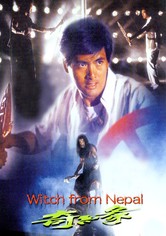
Find anything you save across the site in your account
Why A.I. Isn’t Going to Make Art
In 1953, Roald Dahl published “ The Great Automatic Grammatizator ,” a short story about an electrical engineer who secretly desires to be a writer. One day, after completing construction of the world’s fastest calculating machine, the engineer realizes that “English grammar is governed by rules that are almost mathematical in their strictness.” He constructs a fiction-writing machine that can produce a five-thousand-word short story in thirty seconds; a novel takes fifteen minutes and requires the operator to manipulate handles and foot pedals, as if he were driving a car or playing an organ, to regulate the levels of humor and pathos. The resulting novels are so popular that, within a year, half the fiction published in English is a product of the engineer’s invention.
Is there anything about art that makes us think it can’t be created by pushing a button, as in Dahl’s imagination? Right now, the fiction generated by large language models like ChatGPT is terrible, but one can imagine that such programs might improve in the future. How good could they get? Could they get better than humans at writing fiction—or making paintings or movies—in the same way that calculators are better at addition and subtraction?
Art is notoriously hard to define, and so are the differences between good art and bad art. But let me offer a generalization: art is something that results from making a lot of choices. This might be easiest to explain if we use fiction writing as an example. When you are writing fiction, you are—consciously or unconsciously—making a choice about almost every word you type; to oversimplify, we can imagine that a ten-thousand-word short story requires something on the order of ten thousand choices. When you give a generative-A.I. program a prompt, you are making very few choices; if you supply a hundred-word prompt, you have made on the order of a hundred choices.
If an A.I. generates a ten-thousand-word story based on your prompt, it has to fill in for all of the choices that you are not making. There are various ways it can do this. One is to take an average of the choices that other writers have made, as represented by text found on the Internet; that average is equivalent to the least interesting choices possible, which is why A.I.-generated text is often really bland. Another is to instruct the program to engage in style mimicry, emulating the choices made by a specific writer, which produces a highly derivative story. In neither case is it creating interesting art.
I think the same underlying principle applies to visual art, although it’s harder to quantify the choices that a painter might make. Real paintings bear the mark of an enormous number of decisions. By comparison, a person using a text-to-image program like DALL-E enters a prompt such as “A knight in a suit of armor fights a fire-breathing dragon,” and lets the program do the rest. (The newest version of DALL-E accepts prompts of up to four thousand characters—hundreds of words, but not enough to describe every detail of a scene.) Most of the choices in the resulting image have to be borrowed from similar paintings found online; the image might be exquisitely rendered, but the person entering the prompt can’t claim credit for that.
Some commentators imagine that image generators will affect visual culture as much as the advent of photography once did. Although this might seem superficially plausible, the idea that photography is similar to generative A.I. deserves closer examination. When photography was first developed, I suspect it didn’t seem like an artistic medium because it wasn’t apparent that there were a lot of choices to be made; you just set up the camera and start the exposure. But over time people realized that there were a vast number of things you could do with cameras, and the artistry lies in the many choices that a photographer makes. It might not always be easy to articulate what the choices are, but when you compare an amateur’s photos to a professional’s, you can see the difference. So then the question becomes: Is there a similar opportunity to make a vast number of choices using a text-to-image generator? I think the answer is no. An artist—whether working digitally or with paint—implicitly makes far more decisions during the process of making a painting than would fit into a text prompt of a few hundred words.
We can imagine a text-to-image generator that, over the course of many sessions, lets you enter tens of thousands of words into its text box to enable extremely fine-grained control over the image you’re producing; this would be something analogous to Photoshop with a purely textual interface. I’d say that a person could use such a program and still deserve to be called an artist. The film director Bennett Miller has used DALL-E 2 to generate some very striking images that have been exhibited at the Gagosian gallery; to create them, he crafted detailed text prompts and then instructed DALL-E to revise and manipulate the generated images again and again. He generated more than a hundred thousand images to arrive at the twenty images in the exhibit. But he has said that he hasn’t been able to obtain comparable results on later releases of DALL-E . I suspect this might be because Miller was using DALL-E for something it’s not intended to do; it’s as if he hacked Microsoft Paint to make it behave like Photoshop, but as soon as a new version of Paint was released, his hacks stopped working. OpenAI probably isn’t trying to build a product to serve users like Miller, because a product that requires a user to work for months to create an image isn’t appealing to a wide audience. The company wants to offer a product that generates images with little effort.
It’s harder to imagine a program that, over many sessions, helps you write a good novel. This hypothetical writing program might require you to enter a hundred thousand words of prompts in order for it to generate an entirely different hundred thousand words that make up the novel you’re envisioning. It’s not clear to me what such a program would look like. Theoretically, if such a program existed, the user could perhaps deserve to be called the author. But, again, I don’t think companies like OpenAI want to create versions of ChatGPT that require just as much effort from users as writing a novel from scratch. The selling point of generative A.I. is that these programs generate vastly more than you put into them, and that is precisely what prevents them from being effective tools for artists.
The companies promoting generative-A.I. programs claim that they will unleash creativity. In essence, they are saying that art can be all inspiration and no perspiration—but these things cannot be easily separated. I’m not saying that art has to involve tedium. What I’m saying is that art requires making choices at every scale; the countless small-scale choices made during implementation are just as important to the final product as the few large-scale choices made during the conception. It is a mistake to equate “large-scale” with “important” when it comes to the choices made when creating art; the interrelationship between the large scale and the small scale is where the artistry lies.
Believing that inspiration outweighs everything else is, I suspect, a sign that someone is unfamiliar with the medium. I contend that this is true even if one’s goal is to create entertainment rather than high art. People often underestimate the effort required to entertain; a thriller novel may not live up to Kafka’s ideal of a book—an “axe for the frozen sea within us”—but it can still be as finely crafted as a Swiss watch. And an effective thriller is more than its premise or its plot. I doubt you could replace every sentence in a thriller with one that is semantically equivalent and have the resulting novel be as entertaining. This means that its sentences—and the small-scale choices they represent—help to determine the thriller’s effectiveness.
Many novelists have had the experience of being approached by someone convinced that they have a great idea for a novel, which they are willing to share in exchange for a fifty-fifty split of the proceeds. Such a person inadvertently reveals that they think formulating sentences is a nuisance rather than a fundamental part of storytelling in prose. Generative A.I. appeals to people who think they can express themselves in a medium without actually working in that medium. But the creators of traditional novels, paintings, and films are drawn to those art forms because they see the unique expressive potential that each medium affords. It is their eagerness to take full advantage of those potentialities that makes their work satisfying, whether as entertainment or as art.
Of course, most pieces of writing, whether articles or reports or e-mails, do not come with the expectation that they embody thousands of choices. In such cases, is there any harm in automating the task? Let me offer another generalization: any writing that deserves your attention as a reader is the result of effort expended by the person who wrote it. Effort during the writing process doesn’t guarantee the end product is worth reading, but worthwhile work cannot be made without it. The type of attention you pay when reading a personal e-mail is different from the type you pay when reading a business report, but in both cases it is only warranted when the writer put some thought into it.
Recently, Google aired a commercial during the Paris Olympics for Gemini, its competitor to OpenAI’s GPT-4 . The ad shows a father using Gemini to compose a fan letter, which his daughter will send to an Olympic athlete who inspires her. Google pulled the commercial after widespread backlash from viewers; a media professor called it “one of the most disturbing commercials I’ve ever seen.” It’s notable that people reacted this way, even though artistic creativity wasn’t the attribute being supplanted. No one expects a child’s fan letter to an athlete to be extraordinary; if the young girl had written the letter herself, it would likely have been indistinguishable from countless others. The significance of a child’s fan letter—both to the child who writes it and to the athlete who receives it—comes from its being heartfelt rather than from its being eloquent.
Many of us have sent store-bought greeting cards, knowing that it will be clear to the recipient that we didn’t compose the words ourselves. We don’t copy the words from a Hallmark card in our own handwriting, because that would feel dishonest. The programmer Simon Willison has described the training for large language models as “money laundering for copyrighted data,” which I find a useful way to think about the appeal of generative-A.I. programs: they let you engage in something like plagiarism, but there’s no guilt associated with it because it’s not clear even to you that you’re copying.
Some have claimed that large language models are not laundering the texts they’re trained on but, rather, learning from them, in the same way that human writers learn from the books they’ve read. But a large language model is not a writer; it’s not even a user of language. Language is, by definition, a system of communication, and it requires an intention to communicate. Your phone’s auto-complete may offer good suggestions or bad ones, but in neither case is it trying to say anything to you or the person you’re texting. The fact that ChatGPT can generate coherent sentences invites us to imagine that it understands language in a way that your phone’s auto-complete does not, but it has no more intention to communicate.
It is very easy to get ChatGPT to emit a series of words such as “I am happy to see you.” There are many things we don’t understand about how large language models work, but one thing we can be sure of is that ChatGPT is not happy to see you. A dog can communicate that it is happy to see you, and so can a prelinguistic child, even though both lack the capability to use words. ChatGPT feels nothing and desires nothing, and this lack of intention is why ChatGPT is not actually using language. What makes the words “I’m happy to see you” a linguistic utterance is not that the sequence of text tokens that it is made up of are well formed; what makes it a linguistic utterance is the intention to communicate something.
Because language comes so easily to us, it’s easy to forget that it lies on top of these other experiences of subjective feeling and of wanting to communicate that feeling. We’re tempted to project those experiences onto a large language model when it emits coherent sentences, but to do so is to fall prey to mimicry; it’s the same phenomenon as when butterflies evolve large dark spots on their wings that can fool birds into thinking they’re predators with big eyes. There is a context in which the dark spots are sufficient; birds are less likely to eat a butterfly that has them, and the butterfly doesn’t really care why it’s not being eaten, as long as it gets to live. But there is a big difference between a butterfly and a predator that poses a threat to a bird.
A person using generative A.I. to help them write might claim that they are drawing inspiration from the texts the model was trained on, but I would again argue that this differs from what we usually mean when we say one writer draws inspiration from another. Consider a college student who turns in a paper that consists solely of a five-page quotation from a book, stating that this quotation conveys exactly what she wanted to say, better than she could say it herself. Even if the student is completely candid with the instructor about what she’s done, it’s not accurate to say that she is drawing inspiration from the book she’s citing. The fact that a large language model can reword the quotation enough that the source is unidentifiable doesn’t change the fundamental nature of what’s going on.
As the linguist Emily M. Bender has noted, teachers don’t ask students to write essays because the world needs more student essays. The point of writing essays is to strengthen students’ critical-thinking skills; in the same way that lifting weights is useful no matter what sport an athlete plays, writing essays develops skills necessary for whatever job a college student will eventually get. Using ChatGPT to complete assignments is like bringing a forklift into the weight room; you will never improve your cognitive fitness that way.
Not all writing needs to be creative, or heartfelt, or even particularly good; sometimes it simply needs to exist. Such writing might support other goals, such as attracting views for advertising or satisfying bureaucratic requirements. When people are required to produce such text, we can hardly blame them for using whatever tools are available to accelerate the process. But is the world better off with more documents that have had minimal effort expended on them? It would be unrealistic to claim that if we refuse to use large language models, then the requirements to create low-quality text will disappear. However, I think it is inevitable that the more we use large language models to fulfill those requirements, the greater those requirements will eventually become. We are entering an era where someone might use a large language model to generate a document out of a bulleted list, and send it to a person who will use a large language model to condense that document into a bulleted list. Can anyone seriously argue that this is an improvement?
It’s not impossible that one day we will have computer programs that can do anything a human being can do, but, contrary to the claims of the companies promoting A.I., that is not something we’ll see in the next few years. Even in domains that have absolutely nothing to do with creativity, current A.I. programs have profound limitations that give us legitimate reasons to question whether they deserve to be called intelligent at all.
The computer scientist François Chollet has proposed the following distinction: skill is how well you perform at a task, while intelligence is how efficiently you gain new skills. I think this reflects our intuitions about human beings pretty well. Most people can learn a new skill given sufficient practice, but the faster the person picks up the skill, the more intelligent we think the person is. What’s interesting about this definition is that—unlike I.Q. tests—it’s also applicable to nonhuman entities; when a dog learns a new trick quickly, we consider that a sign of intelligence.
In 2019, researchers conducted an experiment in which they taught rats how to drive. They put the rats in little plastic containers with three copper-wire bars; when the mice put their paws on one of these bars, the container would either go forward, or turn left or turn right. The rats could see a plate of food on the other side of the room and tried to get their vehicles to go toward it. The researchers trained the rats for five minutes at a time, and after twenty-four practice sessions, the rats had become proficient at driving. Twenty-four trials were enough to master a task that no rat had likely ever encountered before in the evolutionary history of the species. I think that’s a good demonstration of intelligence.
Now consider the current A.I. programs that are widely acclaimed for their performance. AlphaZero, a program developed by Google’s DeepMind, plays chess better than any human player, but during its training it played forty-four million games, far more than any human can play in a lifetime. For it to master a new game, it will have to undergo a similarly enormous amount of training. By Chollet’s definition, programs like AlphaZero are highly skilled, but they aren’t particularly intelligent, because they aren’t efficient at gaining new skills. It is currently impossible to write a computer program capable of learning even a simple task in only twenty-four trials, if the programmer is not given information about the task beforehand.
Self-driving cars trained on millions of miles of driving can still crash into an overturned trailer truck, because such things are not commonly found in their training data, whereas humans taking their first driving class will know to stop. More than our ability to solve algebraic equations, our ability to cope with unfamiliar situations is a fundamental part of why we consider humans intelligent. Computers will not be able to replace humans until they acquire that type of competence, and that is still a long way off; for the time being, we’re just looking for jobs that can be done with turbocharged auto-complete.
Despite years of hype, the ability of generative A.I. to dramatically increase economic productivity remains theoretical. (Earlier this year, Goldman Sachs released a report titled “Gen AI: Too Much Spend, Too Little Benefit?”) The task that generative A.I. has been most successful at is lowering our expectations, both of the things we read and of ourselves when we write anything for others to read. It is a fundamentally dehumanizing technology because it treats us as less than what we are: creators and apprehenders of meaning. It reduces the amount of intention in the world.
Some individuals have defended large language models by saying that most of what human beings say or write isn’t particularly original. That is true, but it’s also irrelevant. When someone says “I’m sorry” to you, it doesn’t matter that other people have said sorry in the past; it doesn’t matter that “I’m sorry” is a string of text that is statistically unremarkable. If someone is being sincere, their apology is valuable and meaningful, even though apologies have previously been uttered. Likewise, when you tell someone that you’re happy to see them, you are saying something meaningful, even if it lacks novelty.
Something similar holds true for art. Whether you are creating a novel or a painting or a film, you are engaged in an act of communication between you and your audience. What you create doesn’t have to be utterly unlike every prior piece of art in human history to be valuable; the fact that you’re the one who is saying it, the fact that it derives from your unique life experience and arrives at a particular moment in the life of whoever is seeing your work, is what makes it new. We are all products of what has come before us, but it’s by living our lives in interaction with others that we bring meaning into the world. That is something that an auto-complete algorithm can never do, and don’t let anyone tell you otherwise. ♦
New Yorker Favorites
They thought that they’d found the perfect apartment. They weren’t alone .
The world’s oldest temple and the dawn of civilization .
What happened to the whale from “Free Willy.”
It was one of the oldest buildings left downtown. Why not try to save it ?
The religious right’s leading ghostwriter .
After high-school football stars were accused of rape, online vigilantes demanded that justice be served .
A comic strip by Alison Bechdel: the seven-minute semi-sadistic workout .
Sign up for our daily newsletter to receive the best stories from The New Yorker .


IMAGES
VIDEO
COMMENTS
How do you make a video essay? How do you capture footage in the best possible quality? What equipment do you need to do so? How do you record voiceover?Here...
Every video analysis essay should have a central idea, or thesis, that ties the film together. 2. Write a Summary. Starting with a brief allows you and your team to document the answers to the most pressing project concerns. It ensures that everyone participating in the video production is on the same page.
How do you make a video essay? How do you pick an idea, research movies and write a script? Here's my tutorial for how to write a video essay, with more epis...
The line between video essay and video art is blurred when we look at the imaginative re-purposing of texts. Filmscalpel's 12 Silent Men is a good example of this, which was shared as a video essay despite being very similar in form to Vicki Bennett's work of video art, 4:33: The Movie.
Step 1: Craft a thesis. Good video essays will have a central thesis explored throughout the piece. If you can't summarize your thesis in a sentence (sometimes two), you've still got work to do. The best theses immediately leave the viewer wanting to know more.
A video essay is a video that analyzes a specific topic, theme, person or thesis. Because video essays are a rather new form, they can be difficult to define, but recognizable nonetheless. To put it simply, they are essays in video form that aim to persuade, educate, or critique. These essays have become increasingly popular within the era of ...
Video essays are one of the most influential and successful genres here on YouTube. But how are they made? What goes into the crafting of a good video essay ...
In the last 10 years, YouTube video essays — on movies, on TV shows, on games, on pop culture, on everyday life — have entered a renaissance. But how do you make a video essay?
There are already a number of very useful resources on how to make video essays, such as Greer Fyfe and Miriam Ross's ' How-to Video Essays ' (2015) and 'Teaching with Video in the 21st Century: Clips, Essays, Full Length Films and TV Programs' (Butler et al. 2015), both available in The Audiovisual Essay project in the REFRAME website.
Look at all the different things Puschak considers visual rhetoric and think about how he's using the video essay form to make honed, precisely-executed arguments about popular culture. Dennis Hartwig and John P. Hess, FilmmakerIQ. Hartwig and Hess use video essays to explain filmmaking technique to aspiring filmmakers.
This section will give an introductory overview of the stages required to create a video essay. Video essayers advice is to start simple and work through each stage of the video production process. Visit the Resources page of this guide for more. Planning.
Introductory Guide To Video Essays. Drawing on the inspiring work of pioneering educators and researchers engaging with this creative method, this guide aims to offer a research-led introduction for students, teachers and researchers approaching the video essay for the first time.
Video essays as a medium are an important audivisual form of scholarship, particularly in terms of expression, creation, and accessibility. Traditional essays may not always lend themselves to the fullest expression of film and how we interpret/analyze visual images. As students of film and media studies, it is important to both understand the ...
Secrets to Create Successful Video Essays
4. 5. HOW-TO VIDEO ESSAYS. By Greer Fyfe and Miriam Ross. If you have never done any video work before it may seem intimidating at first but you will find it easier than you think if you work through the following steps. Seek help if you get stuck (Google is often a quick solution).
Here's a step-by-step guide to help you with an essay service: 1. Watch the Movie. This is the obvious starting point, but surprisingly many students skip this step. It doesn't matter if you've watched the movie twice before. If you're asked to write an essay about it, you need to watch it again.
A video essay is an audio-visual presentation of your thoughts on a topic or text that usually lasts between 5 and 10 minutes long. It can take the form of any type of media such as film, animation, or even PowerPoint presentations. The most important thing to remember when creating a video essay is to include voiceover narration throughout the ...
Perhaps you are putting together YouTube content such as video essays or movie reviews and you need clips of the source material, or maybe you need footage to learn how to edit or to practice with. Whatever your needs may be, there are a few different ways one can go about sourcing movie footage. We will run through each viable method.
How do you make a good video essay? In this video I give my two cents on the topic, as well as start drama and slag off my peers.Like and subscribe. It's fre...
Following are the steps involved in how to make a video essay: 1. Contemplate your topic wisely. The first and the foremost step in how to make a video essay is to choose a topic for your essays. You can't jump on to other steps before finalizing your topic. Your topic must address a brief content of the essay.
How to Write a Film Analysis Essay: Examples, Outline, & ...
Film Analysis - UNC Writing Center
The Last Holiday Movie Review and the Lesson of Living Life Too Cautiously Titanic Movie Review Quick & Reliable Writing Help As you can see, a movie review essay is an interesting paper to write. Recall that the whole point of a movie review is to inform the reader about the film and the ideas behind it.
How do you make a video essay? How do you edit together footage and voiceover to make an interesting final product? How do you check exports to make sure the...
Every Scream Movie in Order and Where to Watch Them; 10 Great TV Shows Like One Piece You Can Watch Online Right Now; Venice Film Festival 2024: Every Movie in Competition to Add to Your Watchlist; 10 Shows Like House of the Dragon You Can Watch Online Right Now; Every Iron Man Movie in Order (And Where to Stream Them)
The point of writing essays is to strengthen students' critical-thinking skills; in the same way that lifting weights is useful no matter what sport an athlete plays, writing essays develops ...